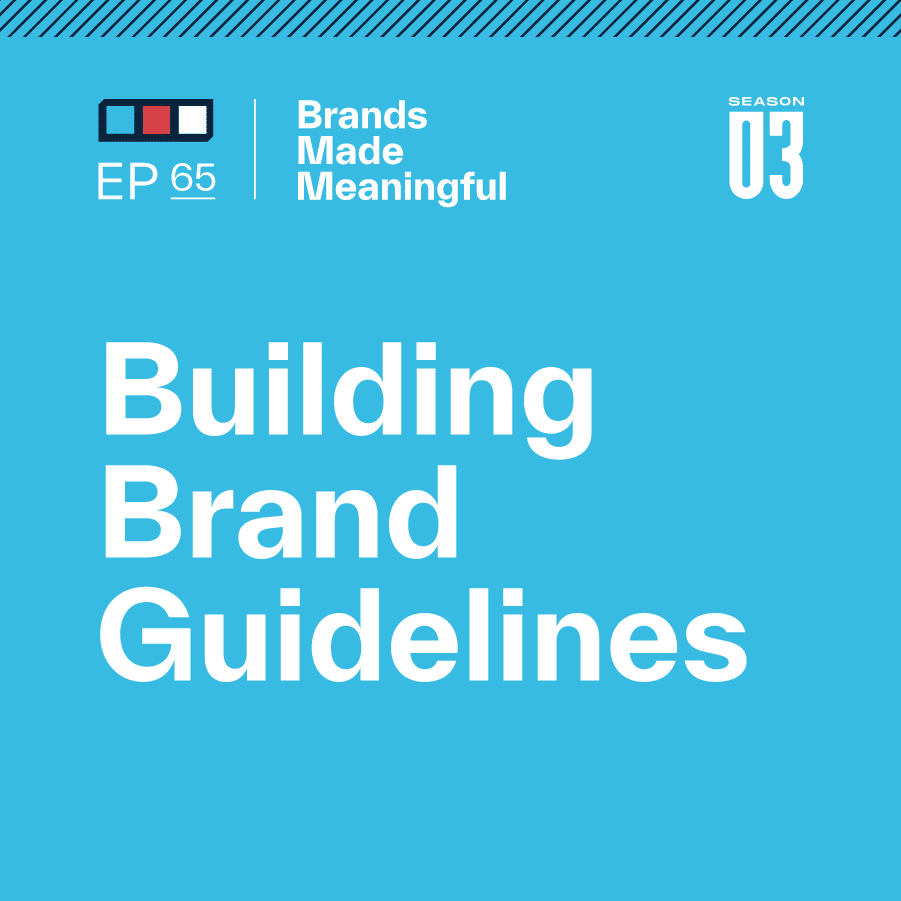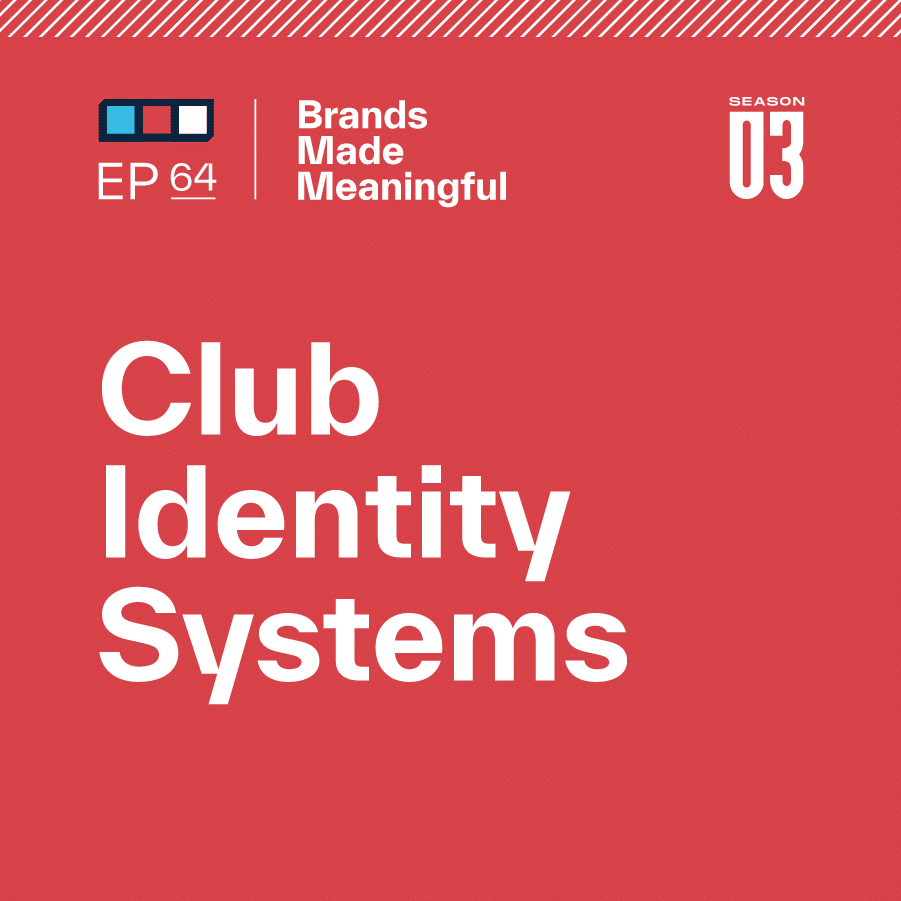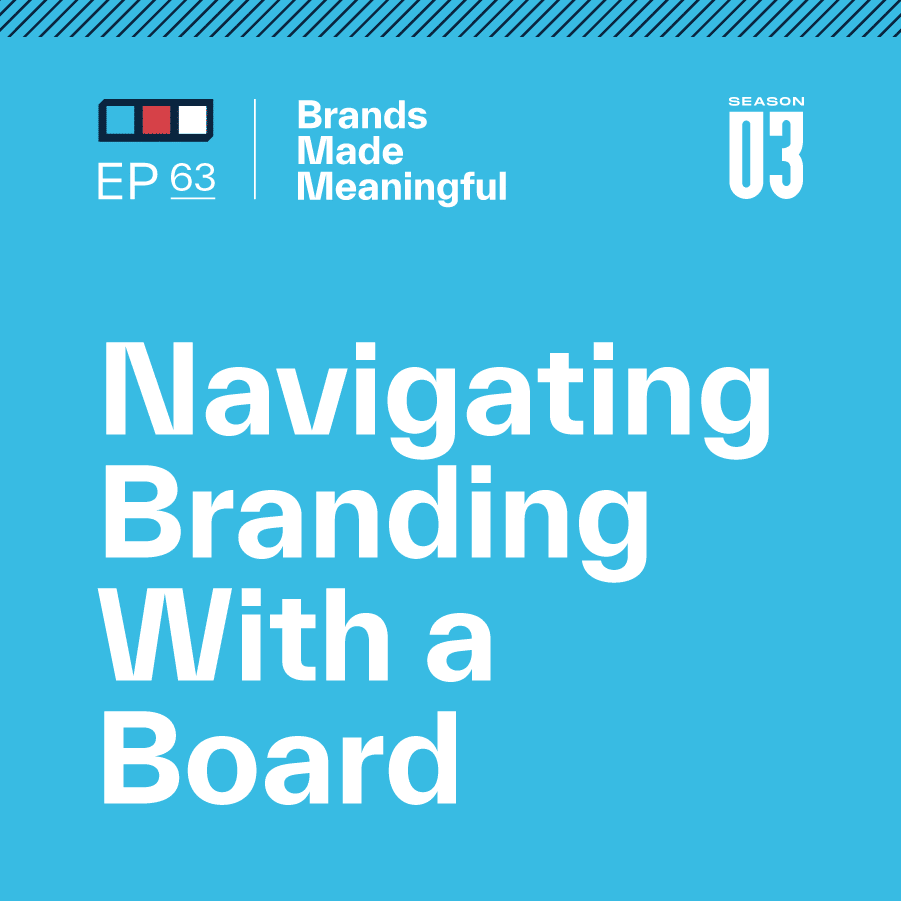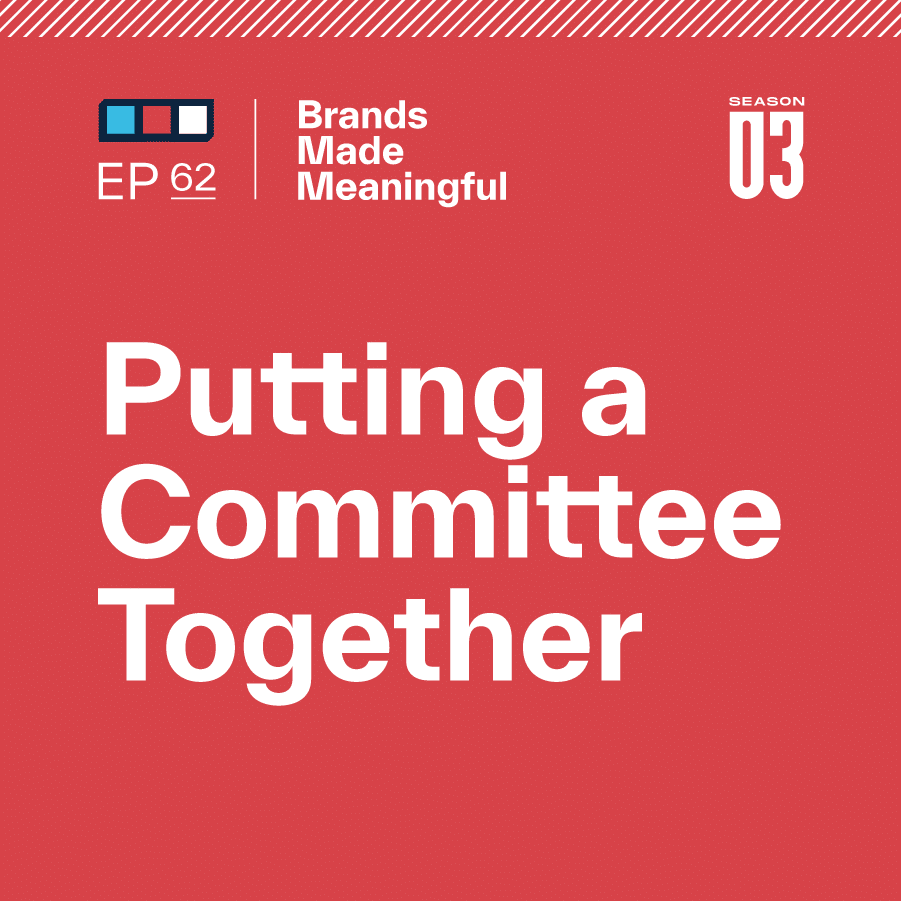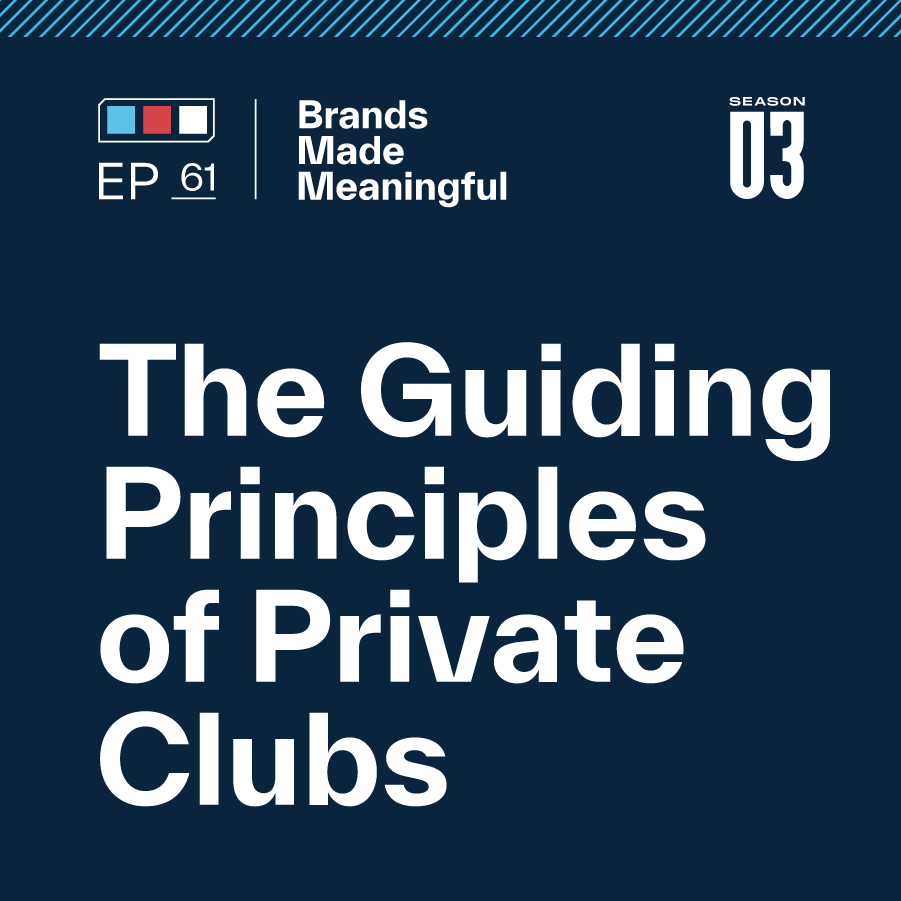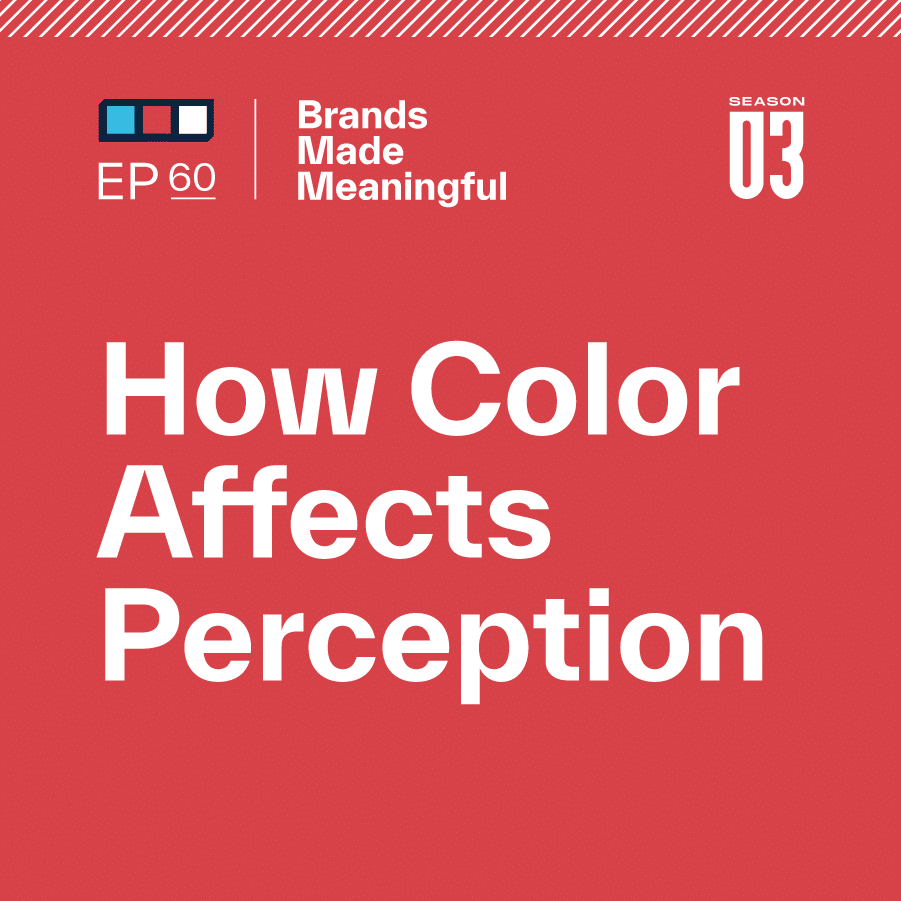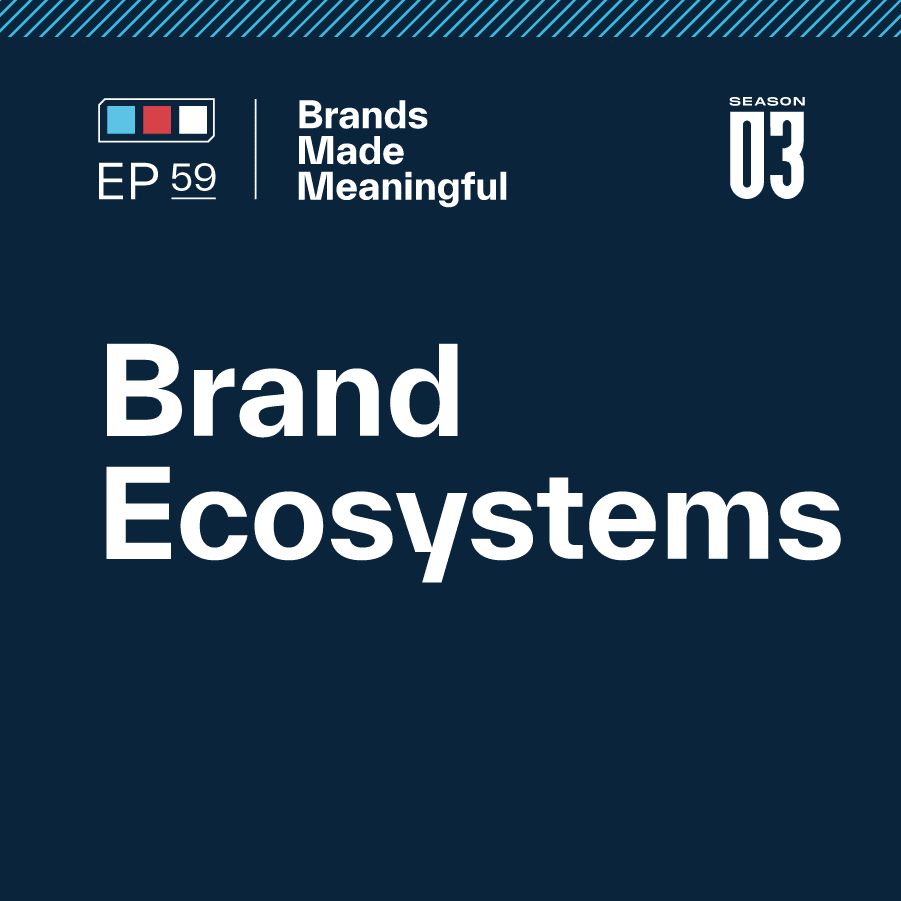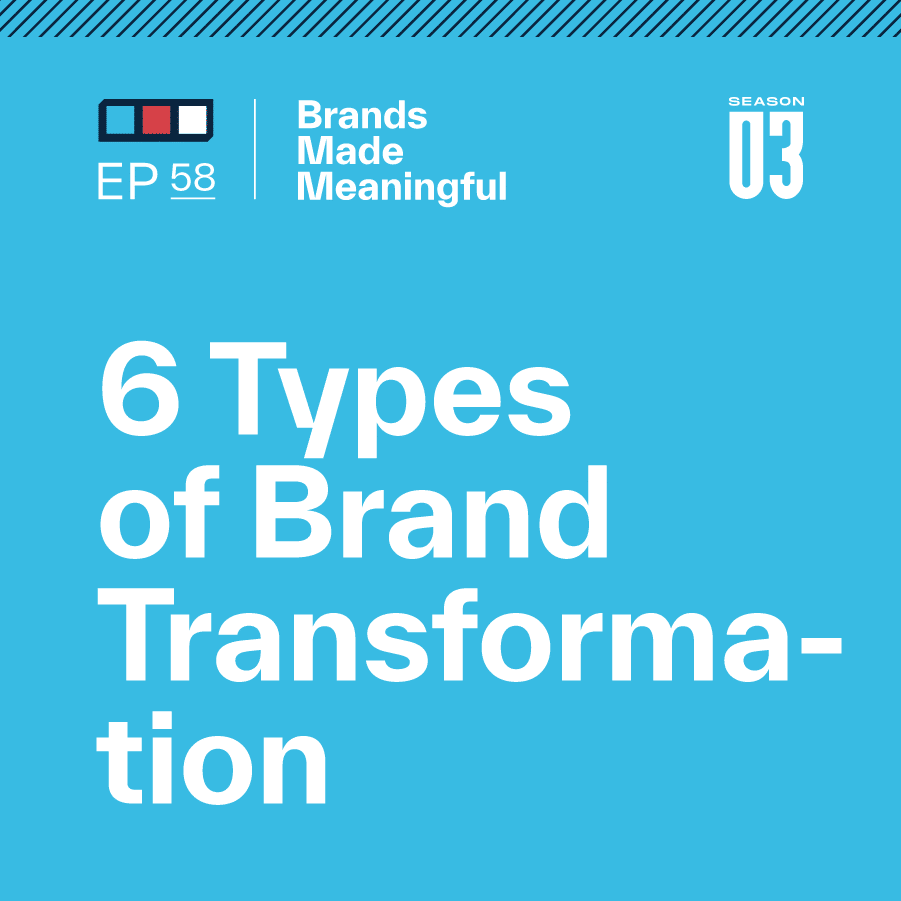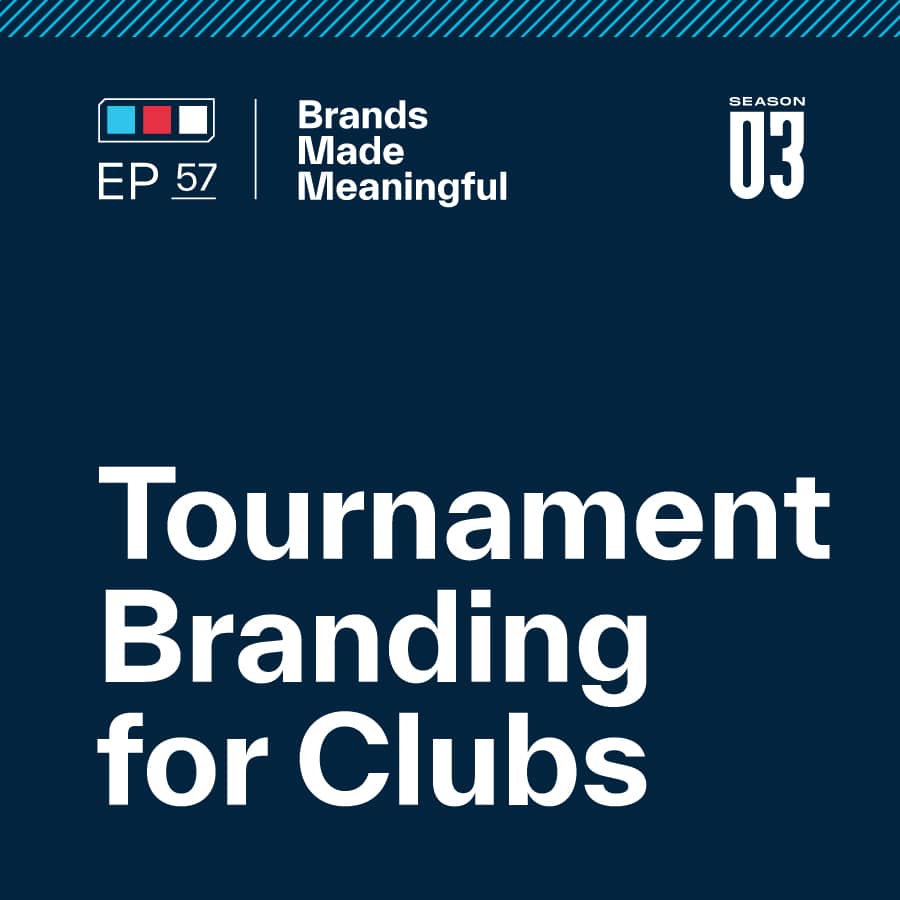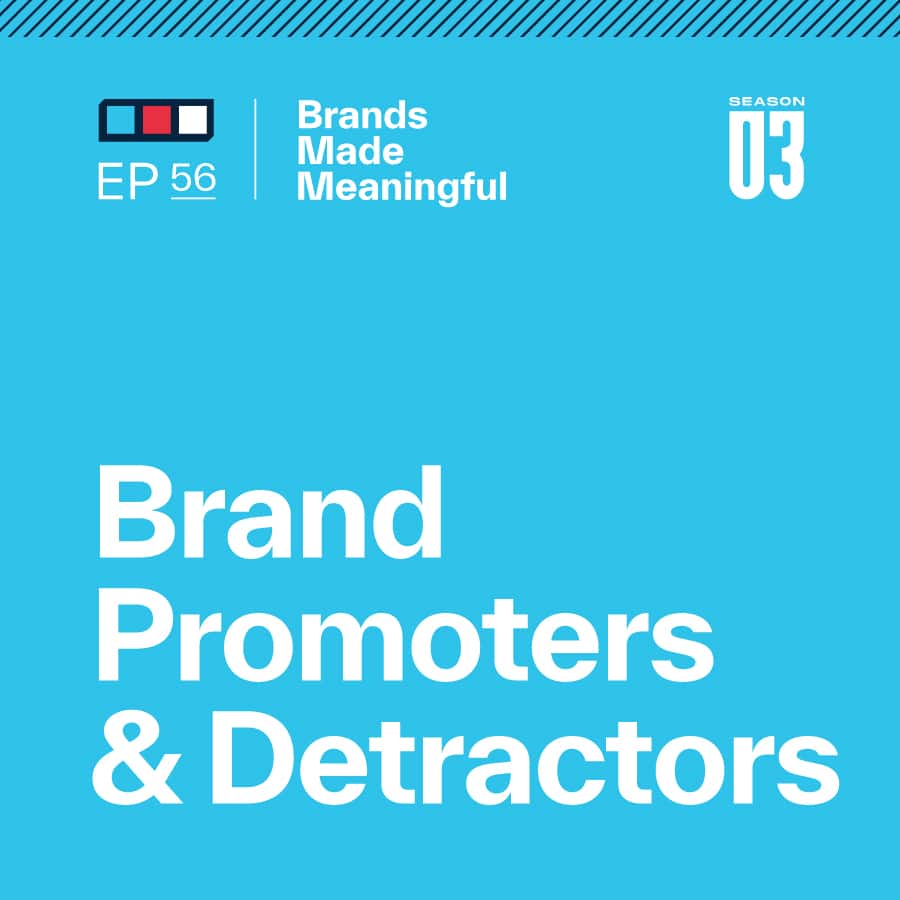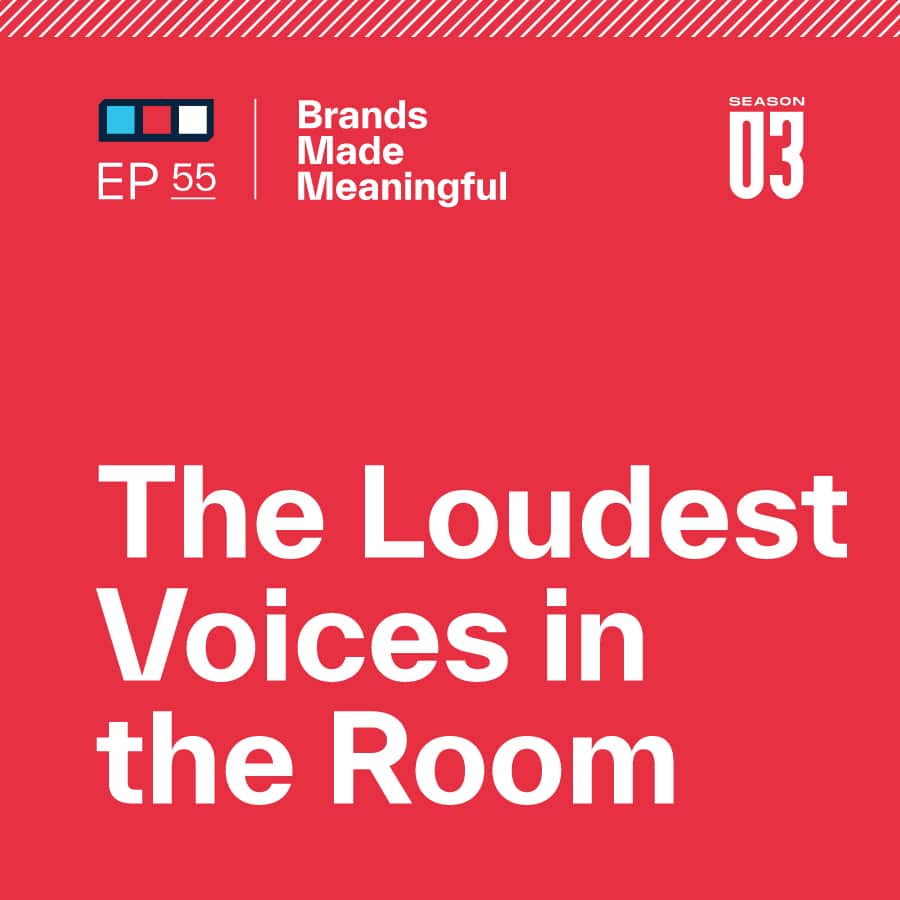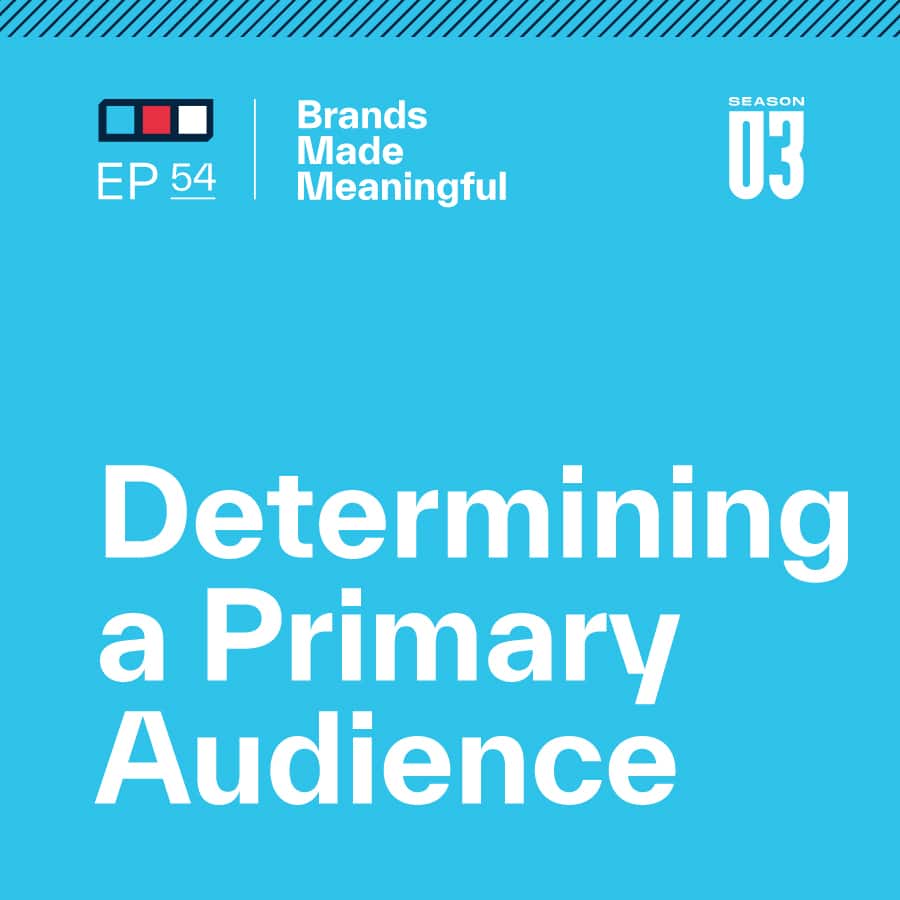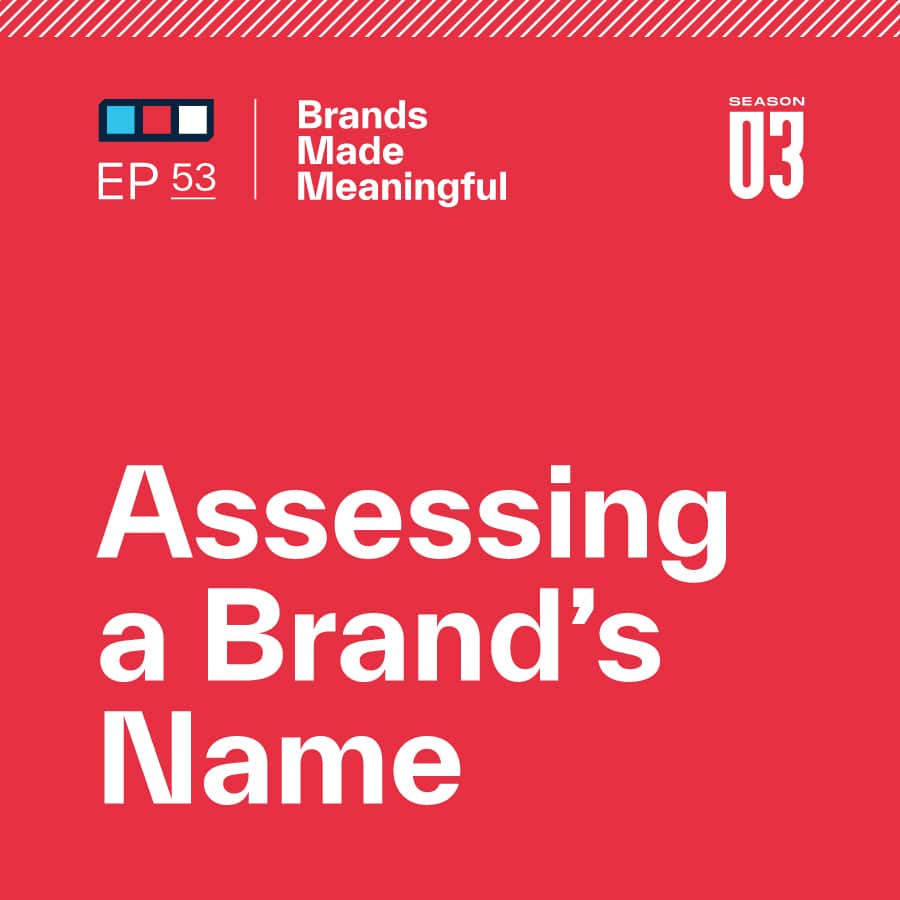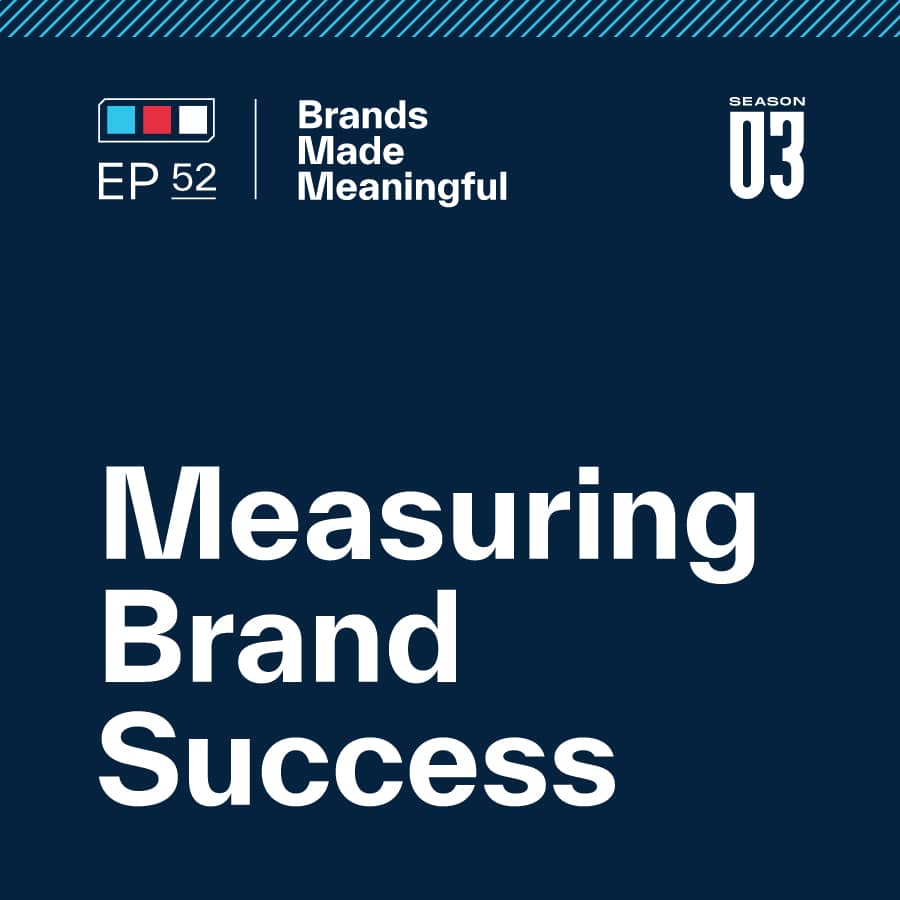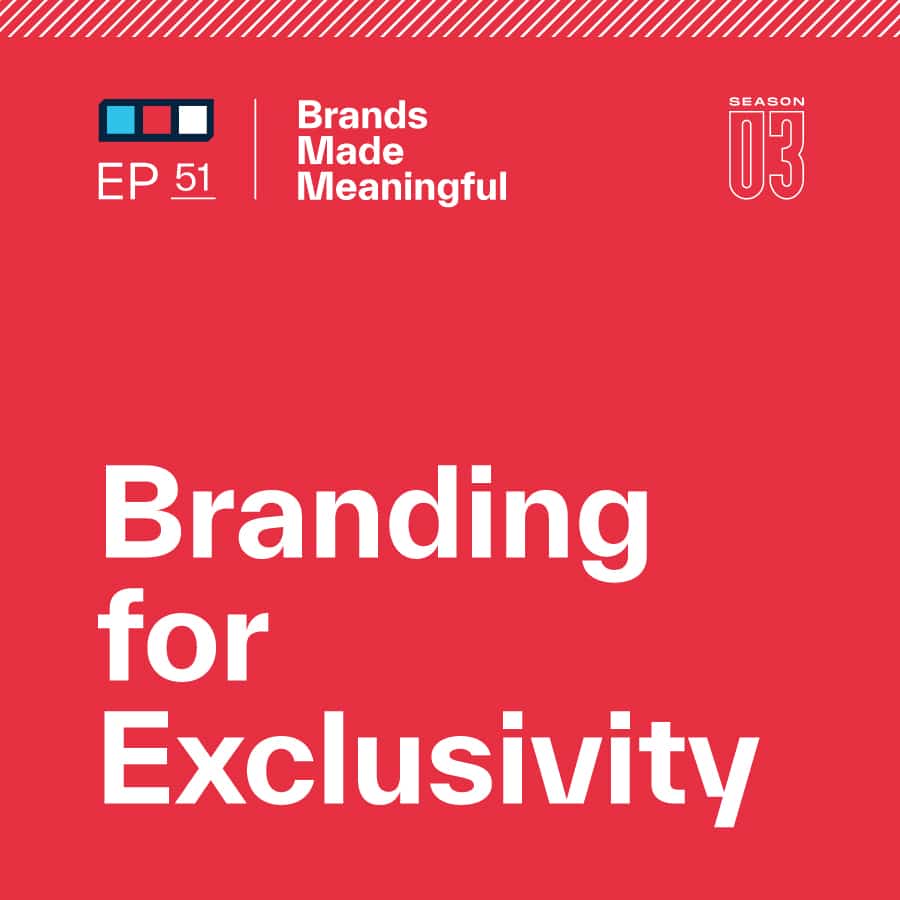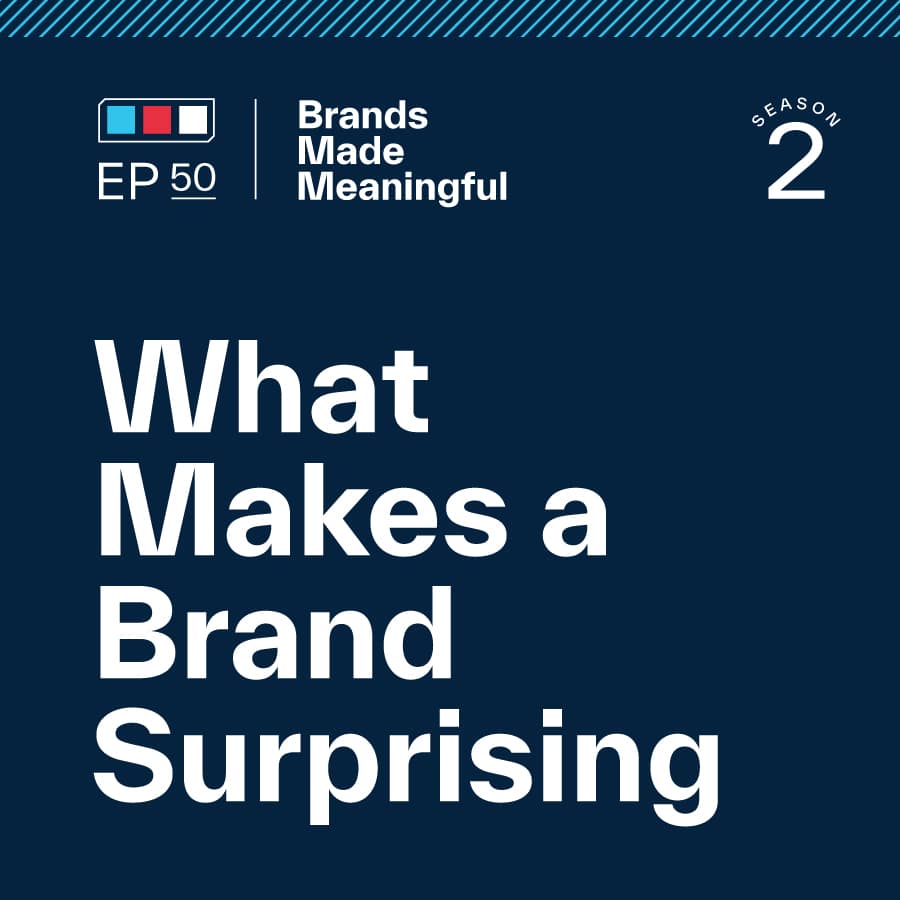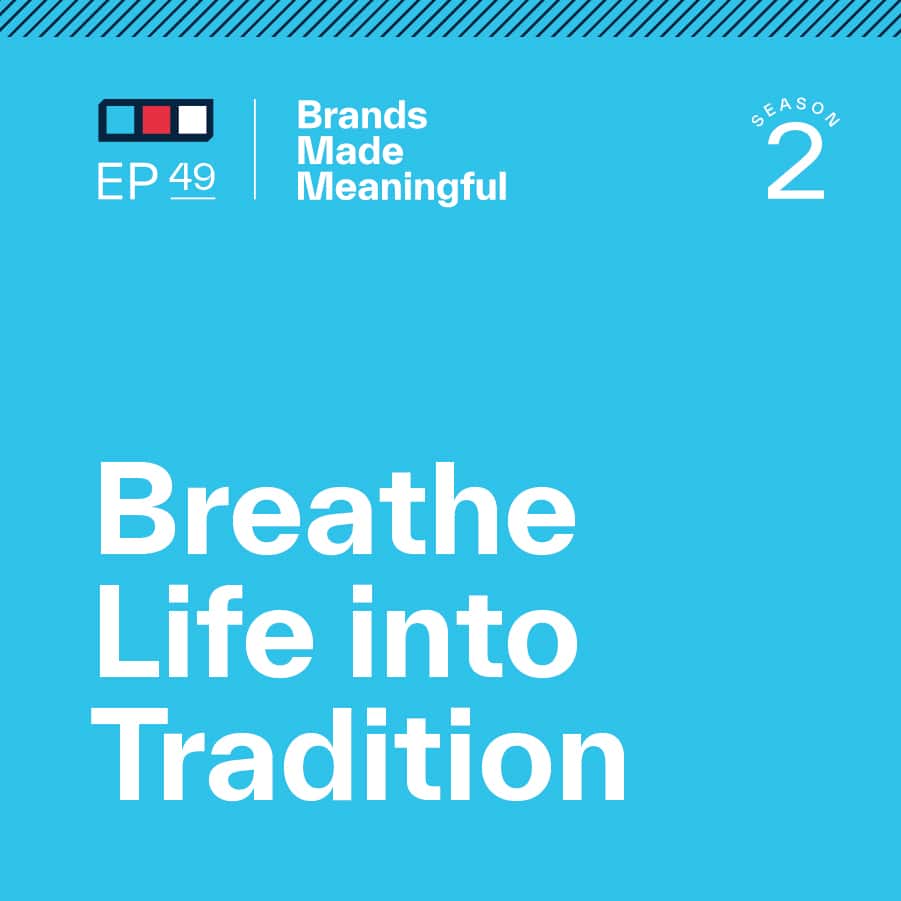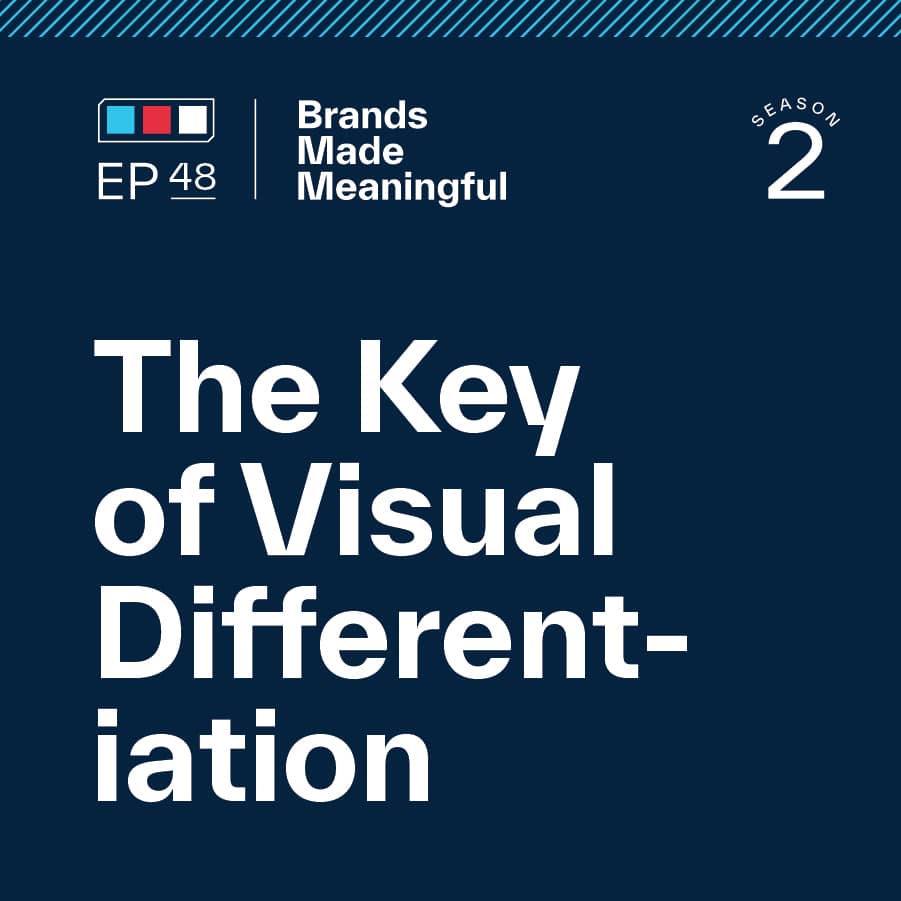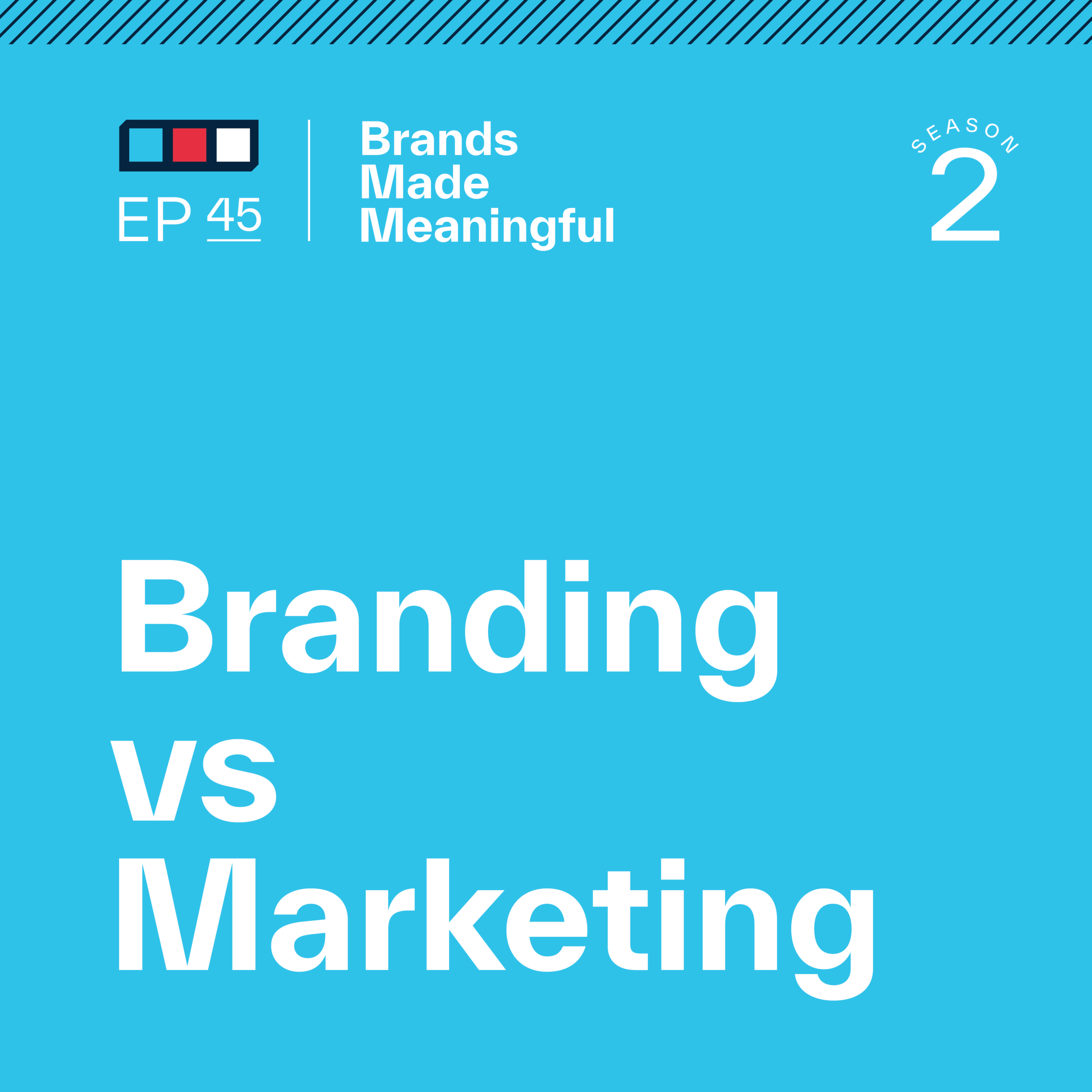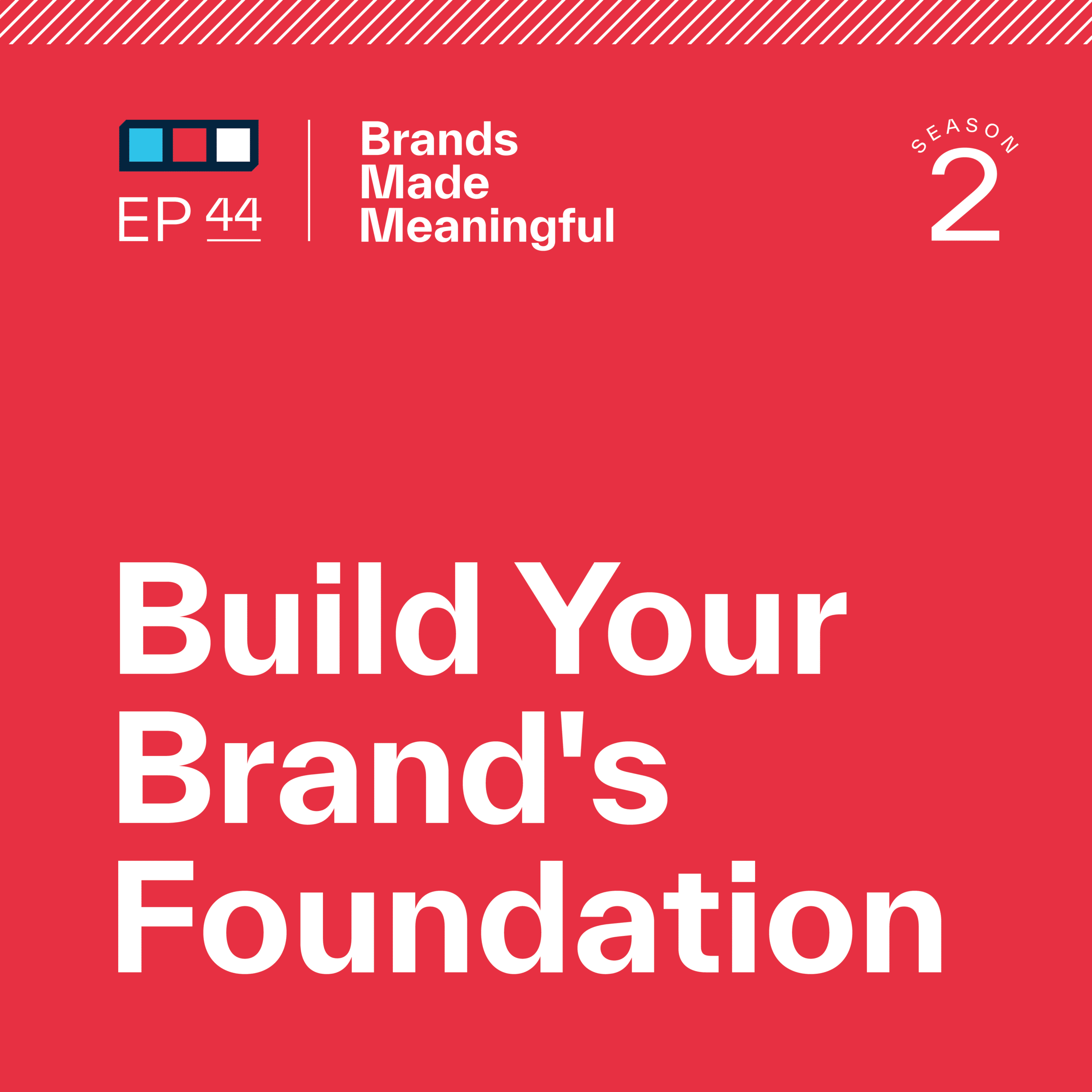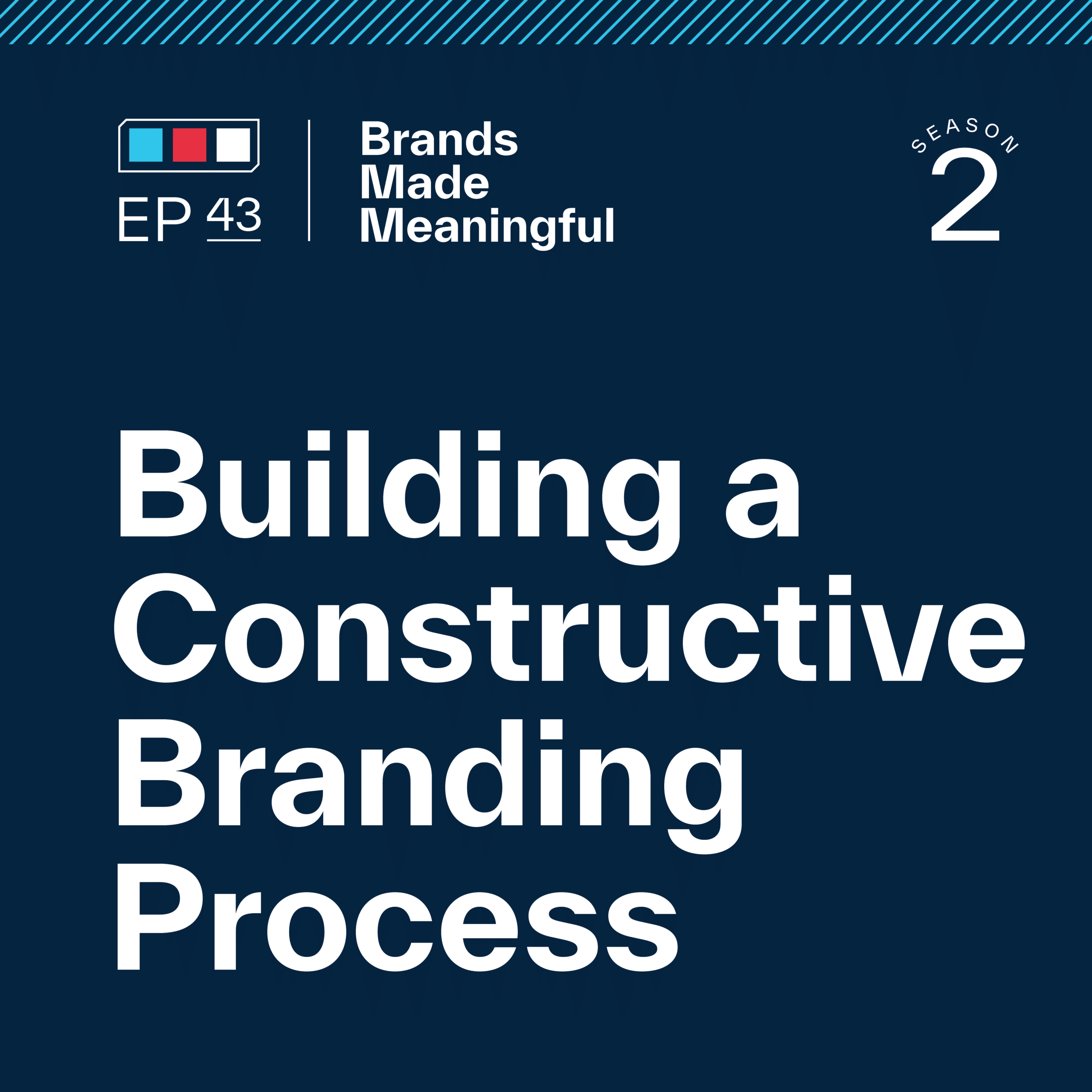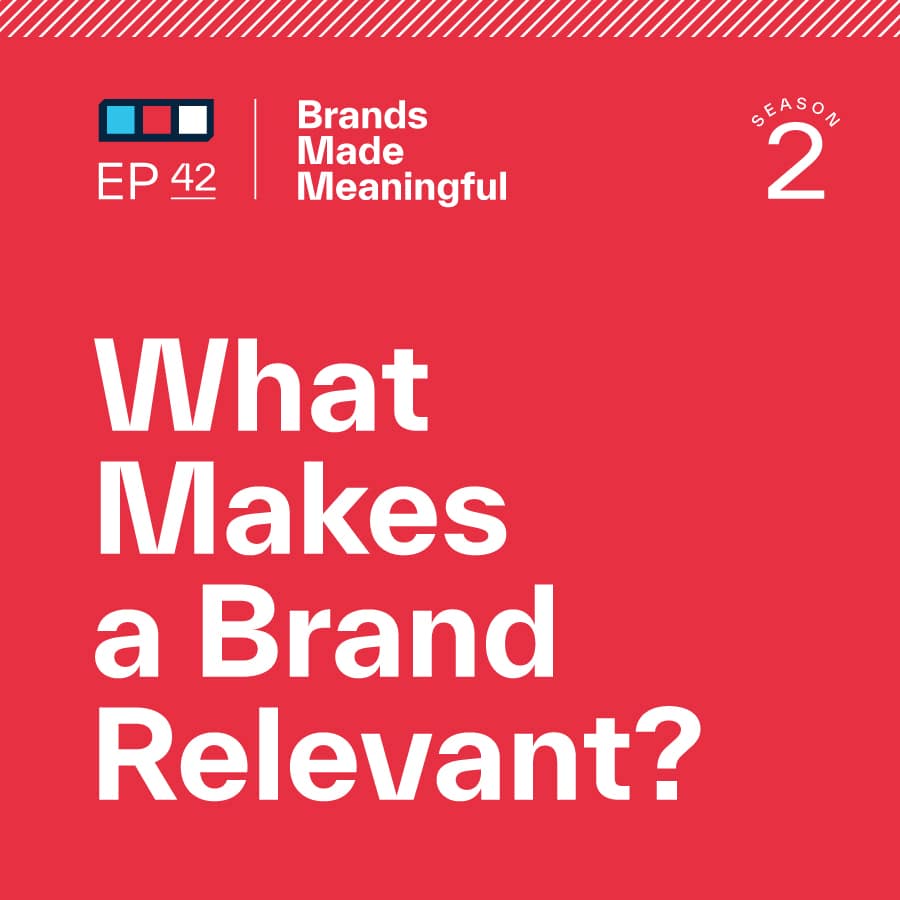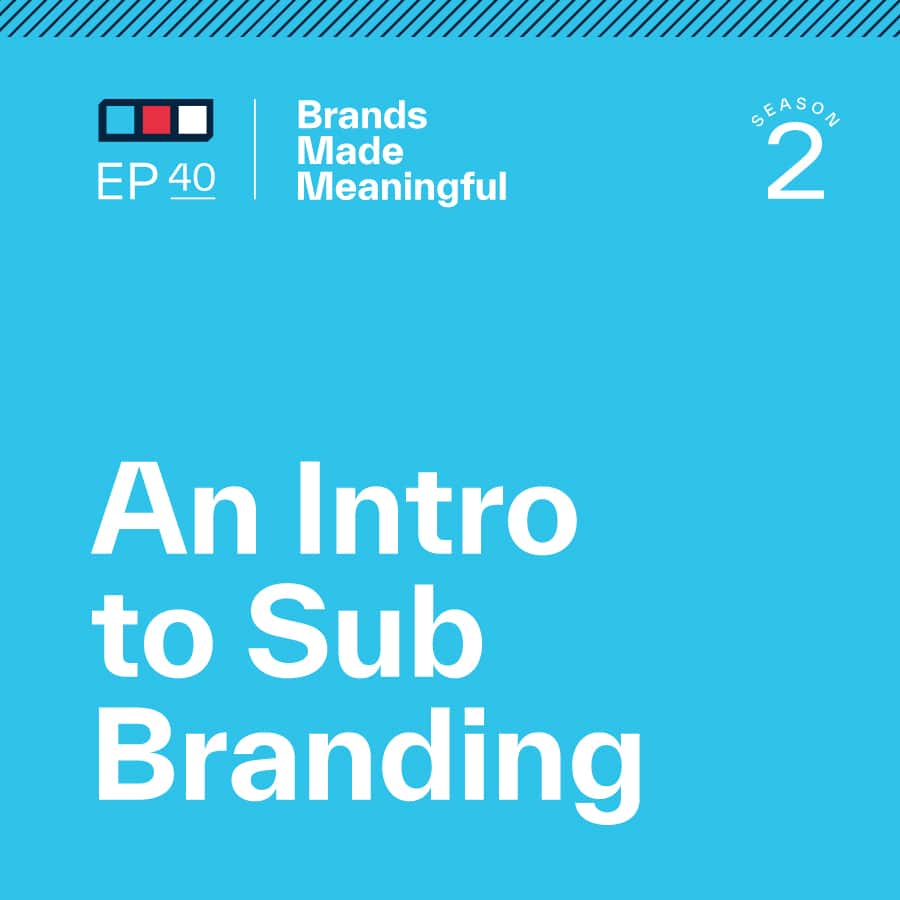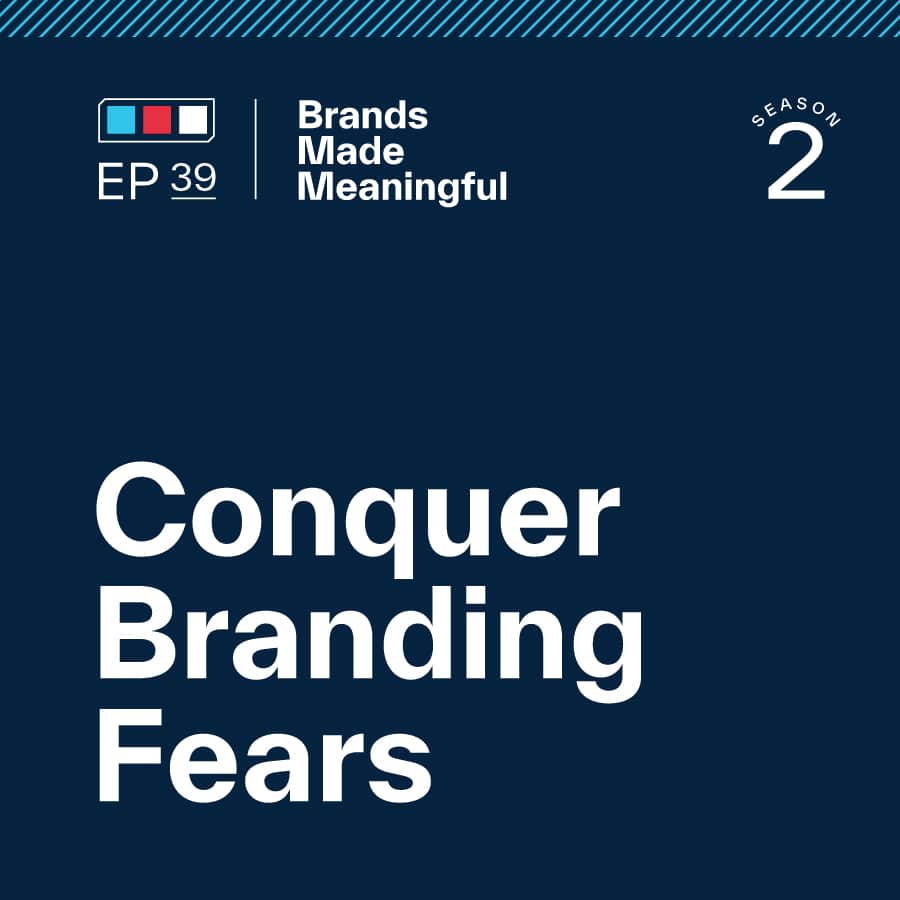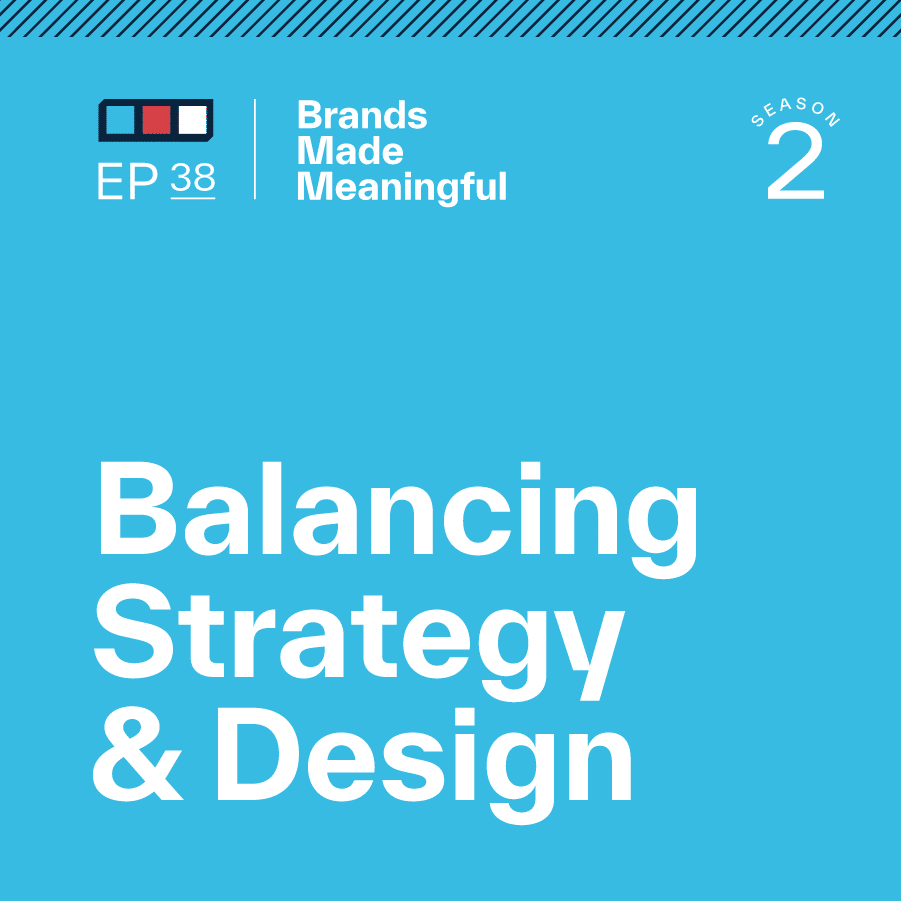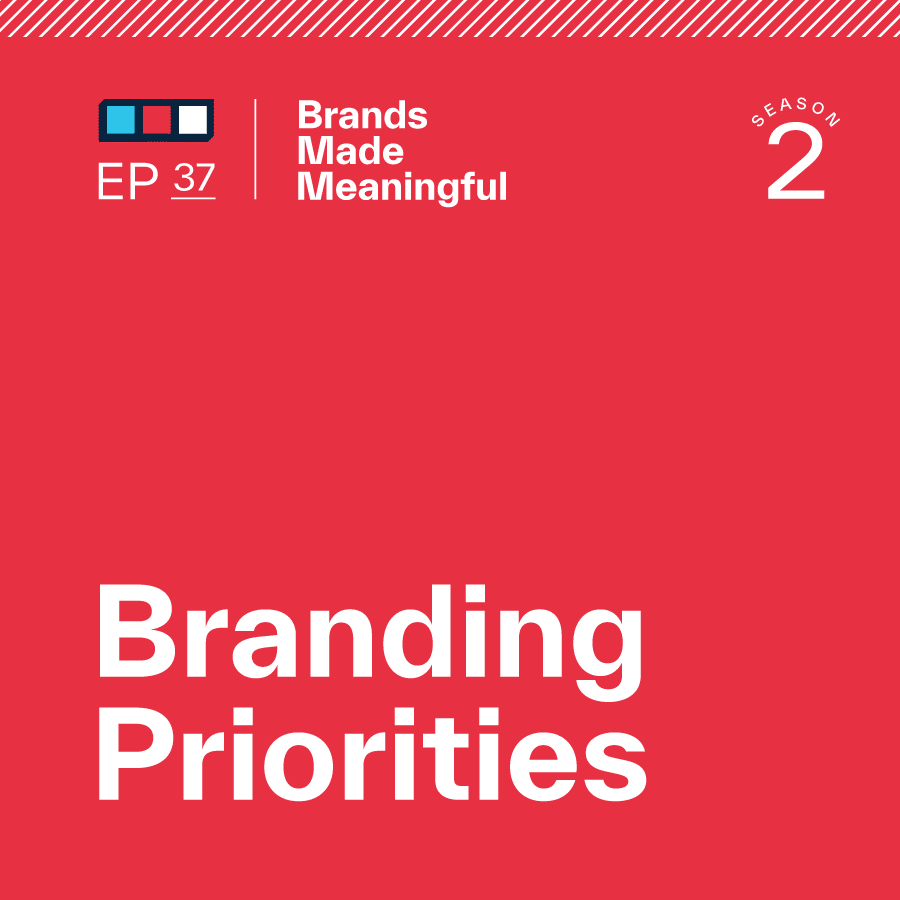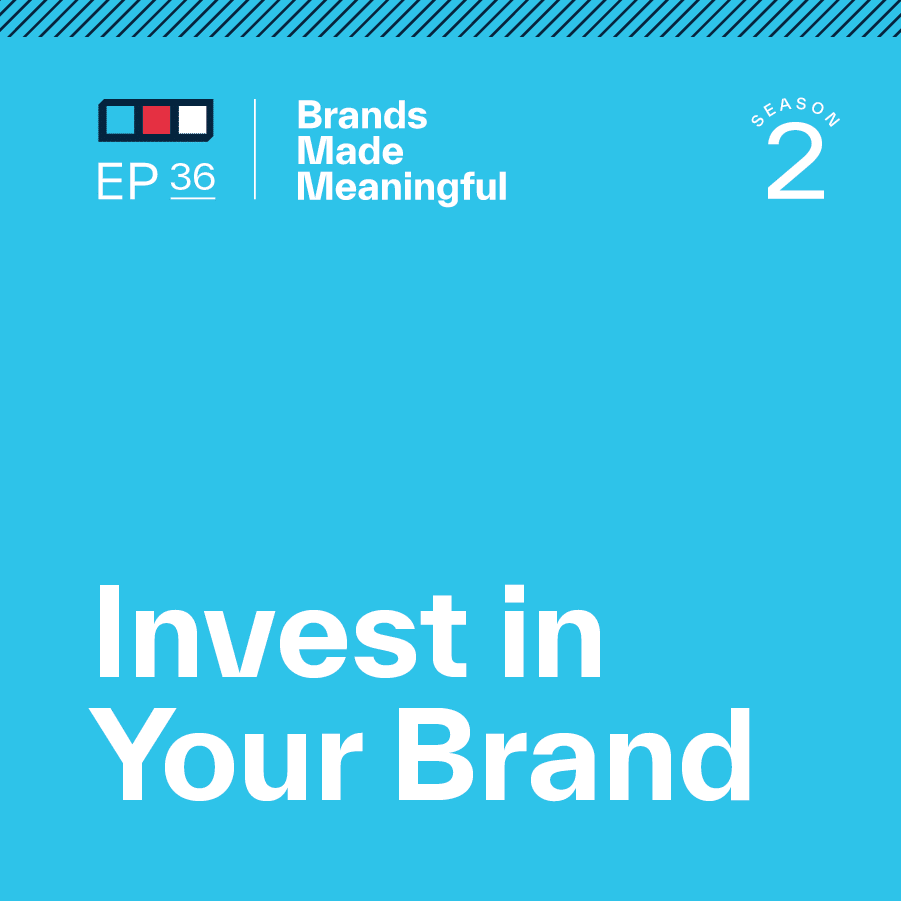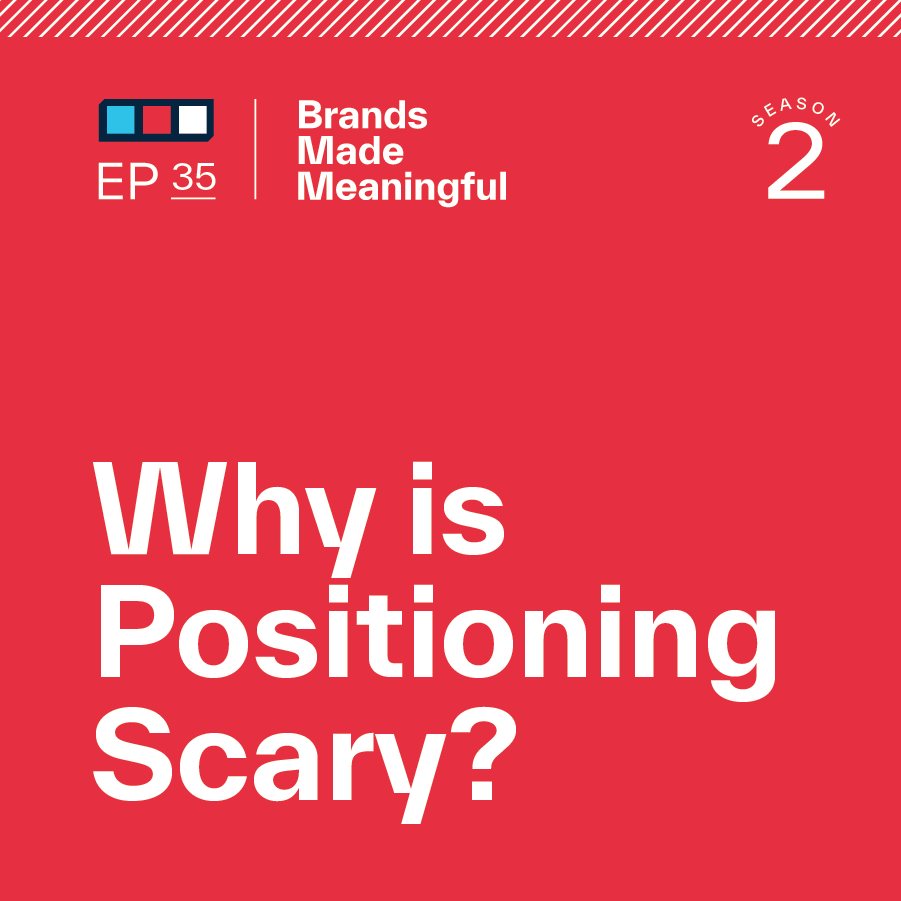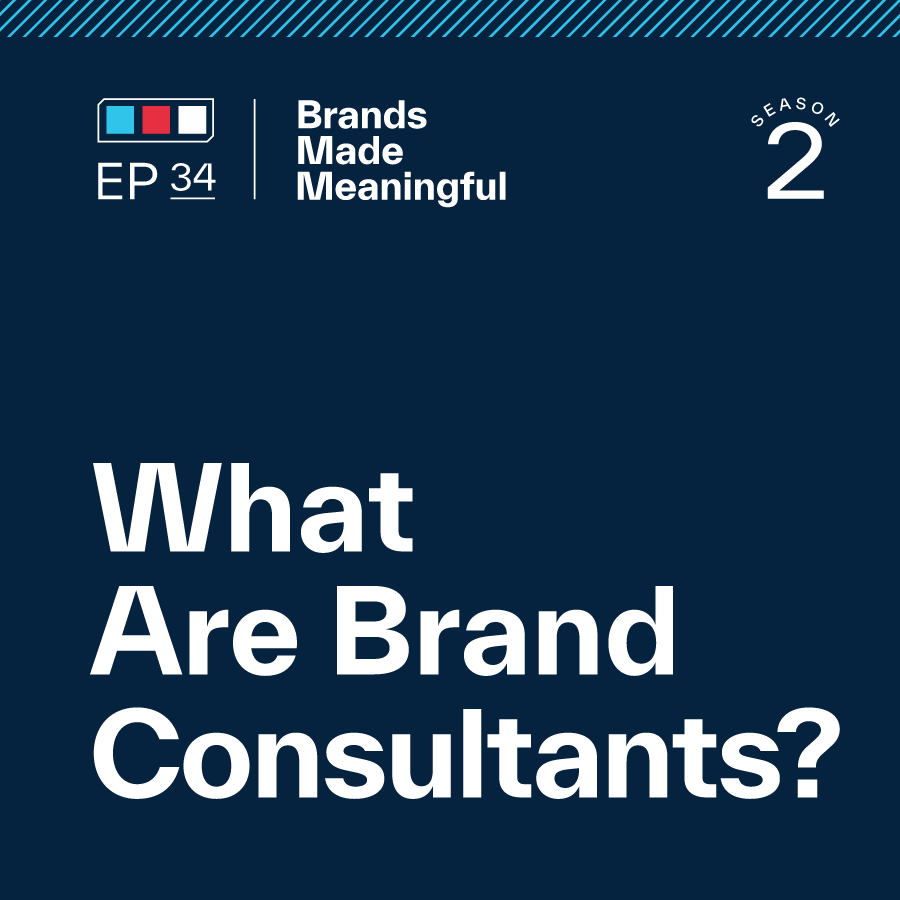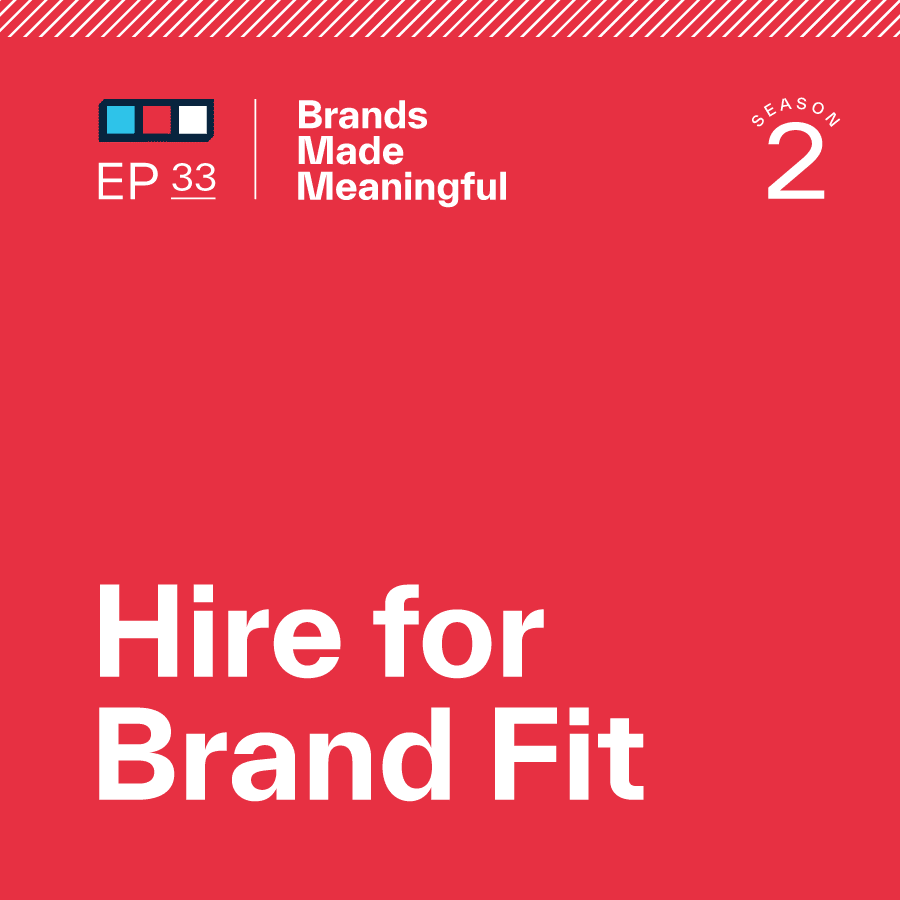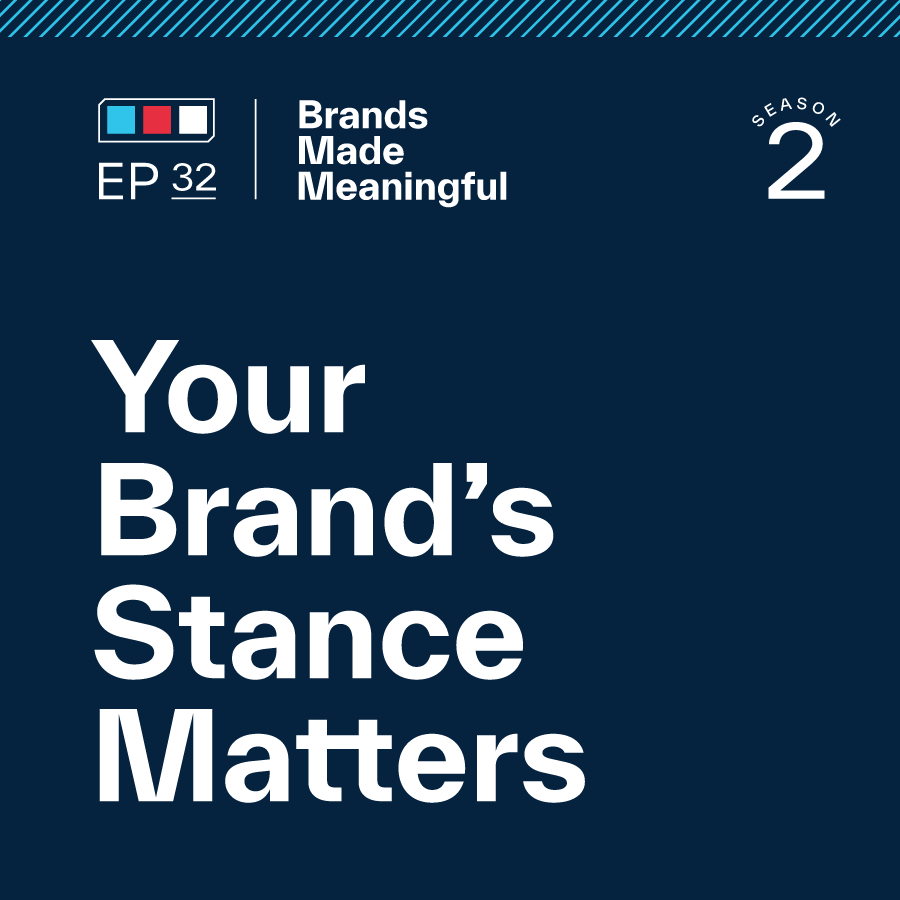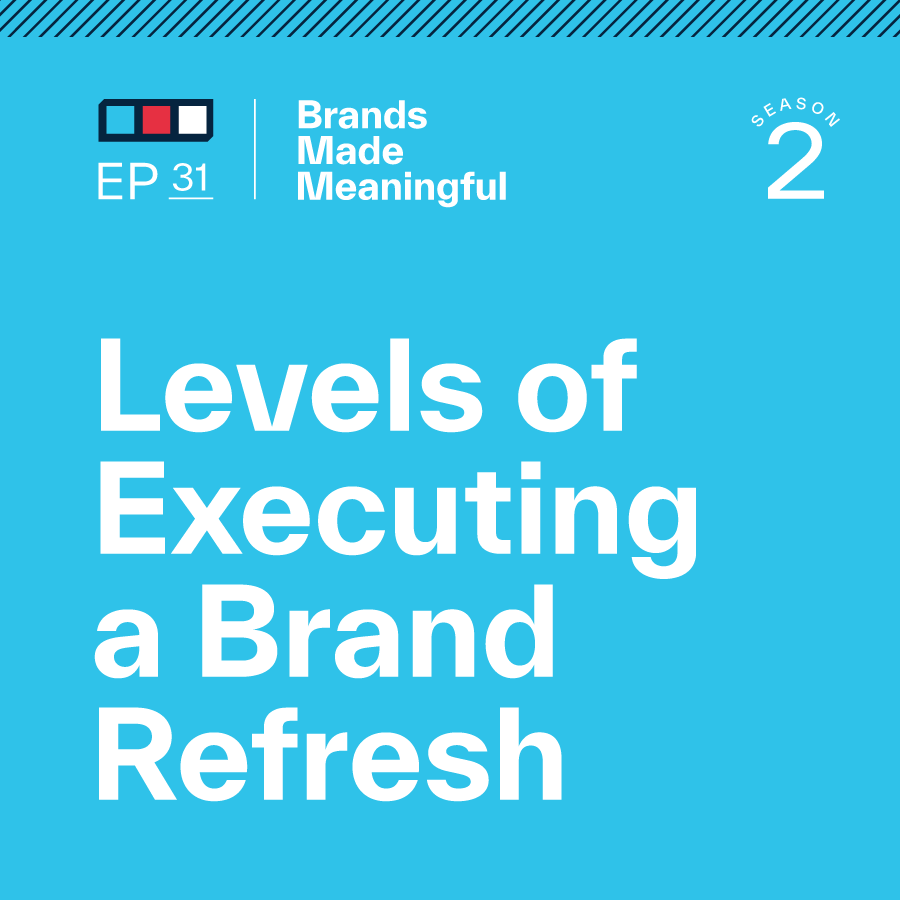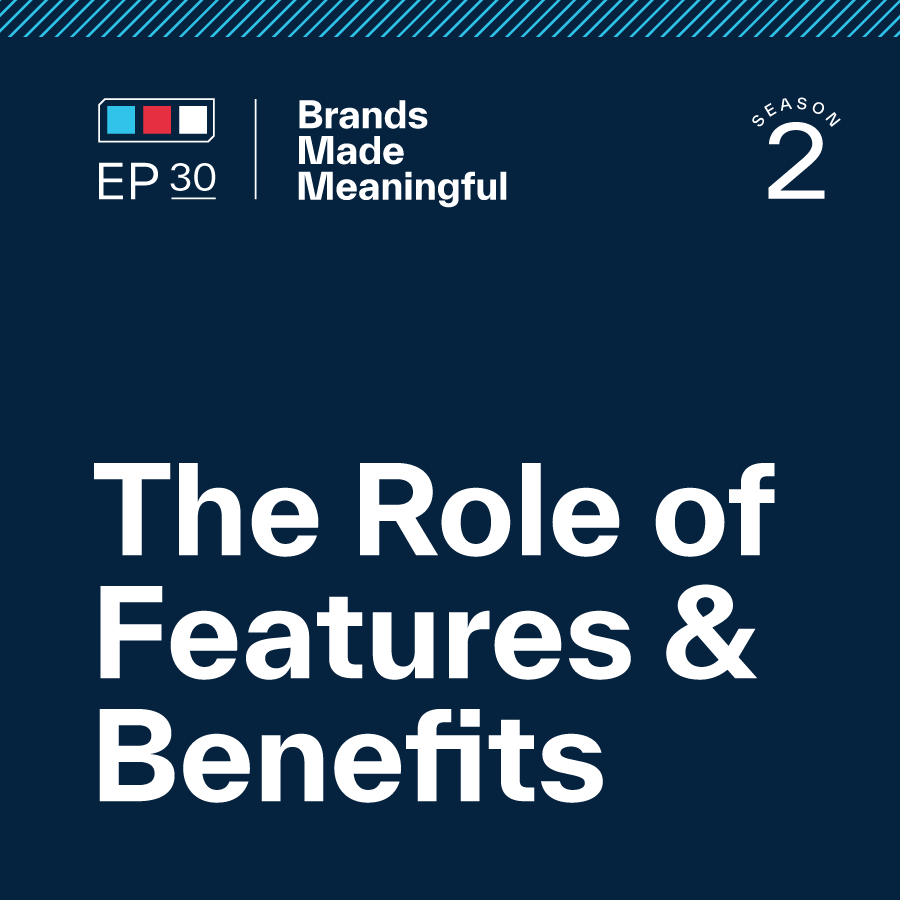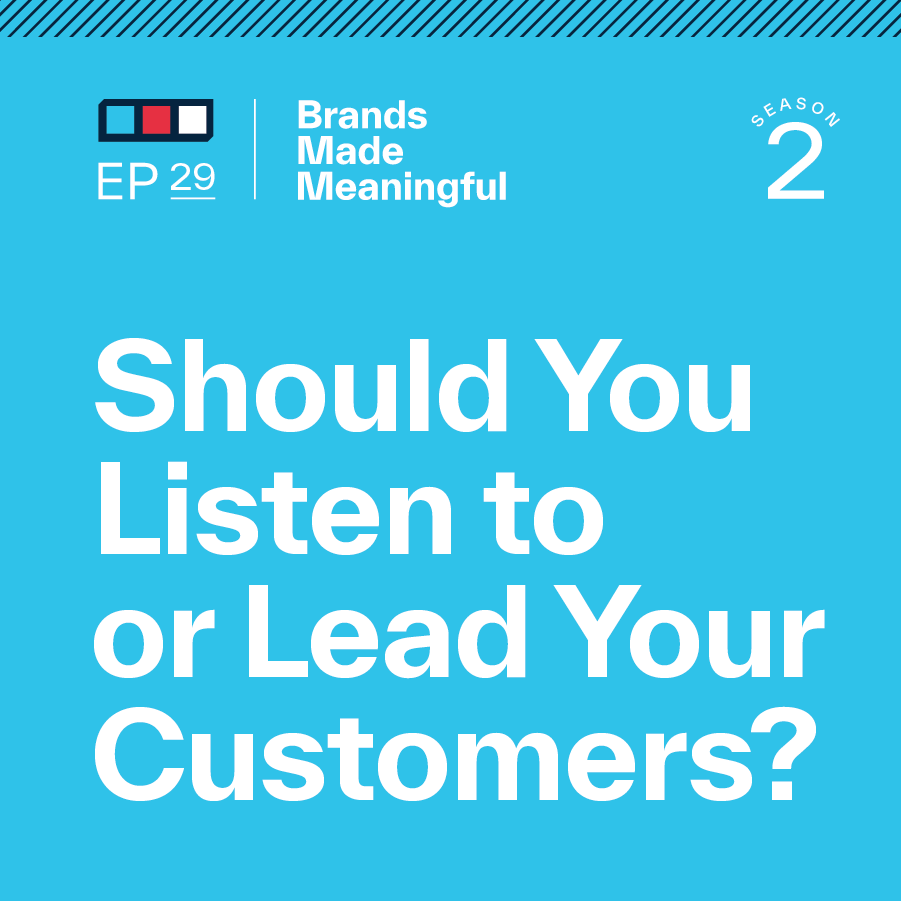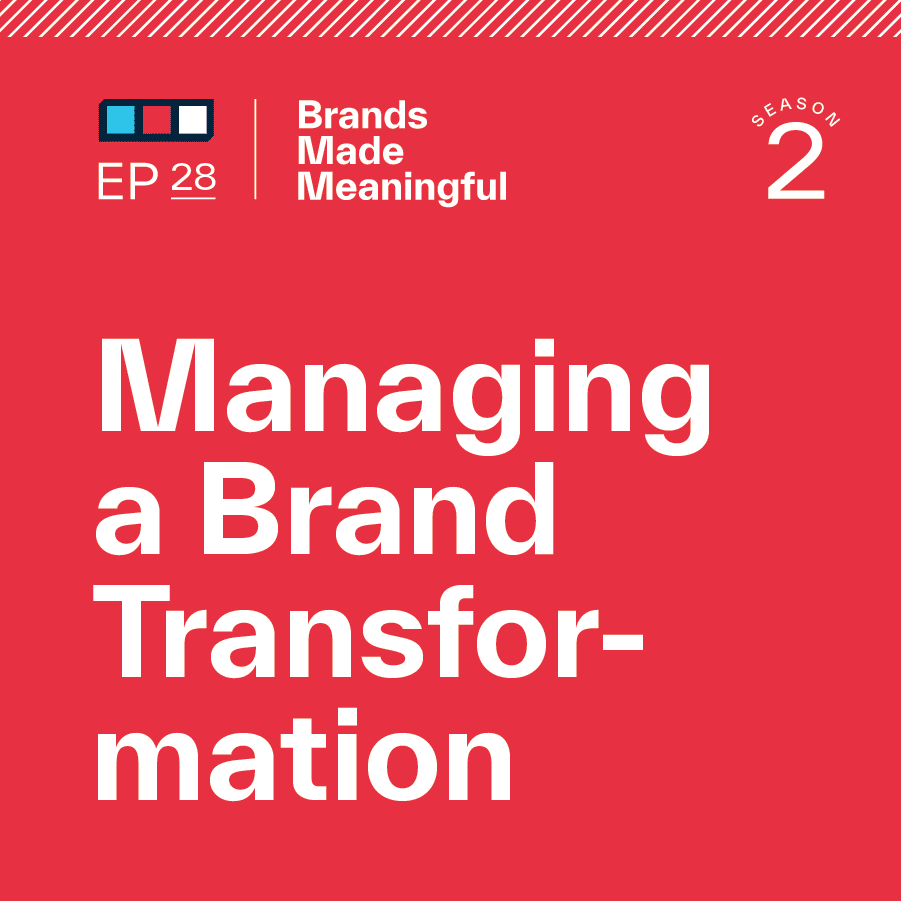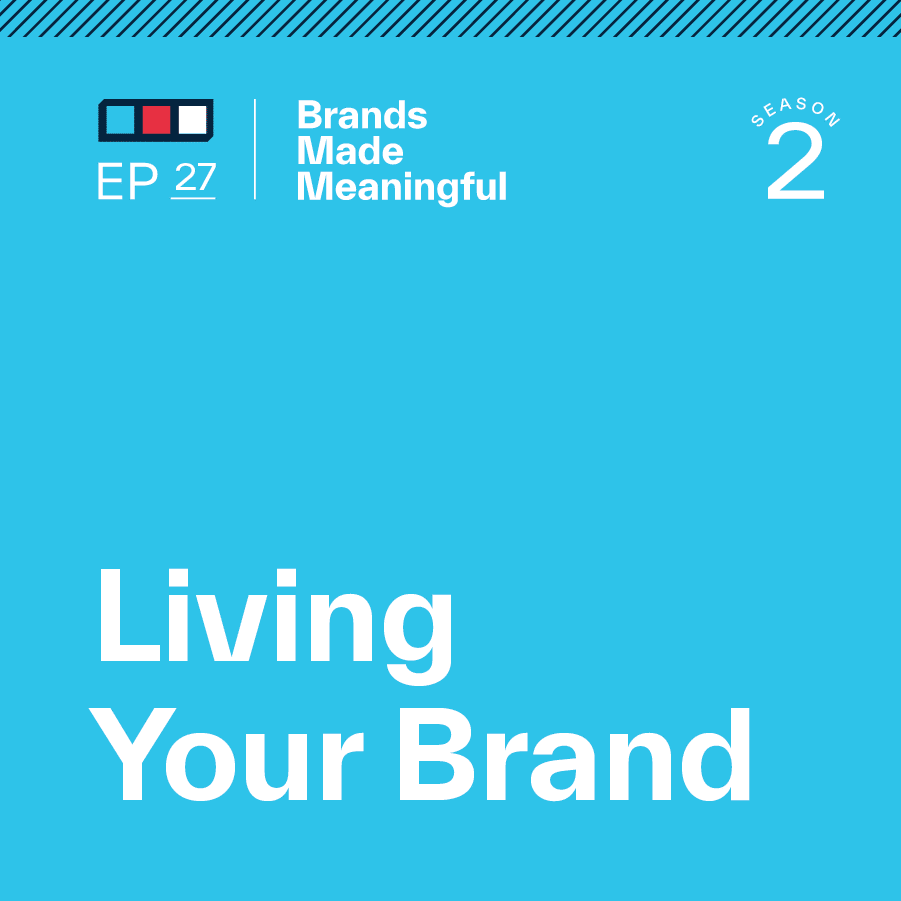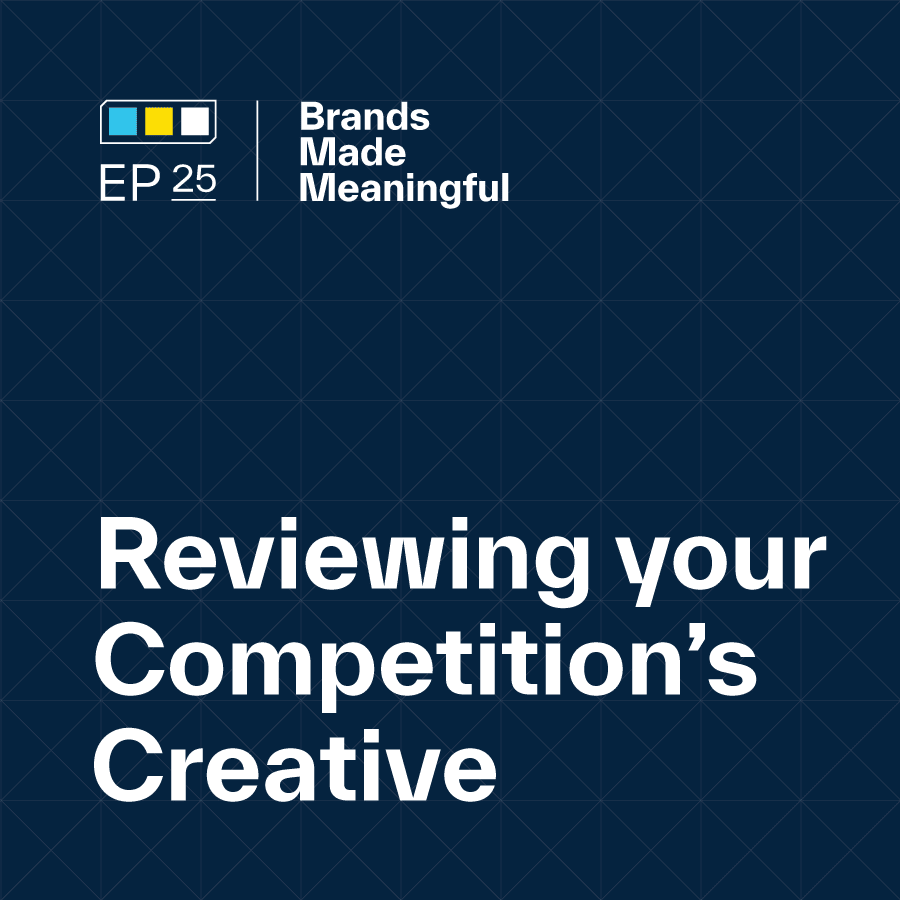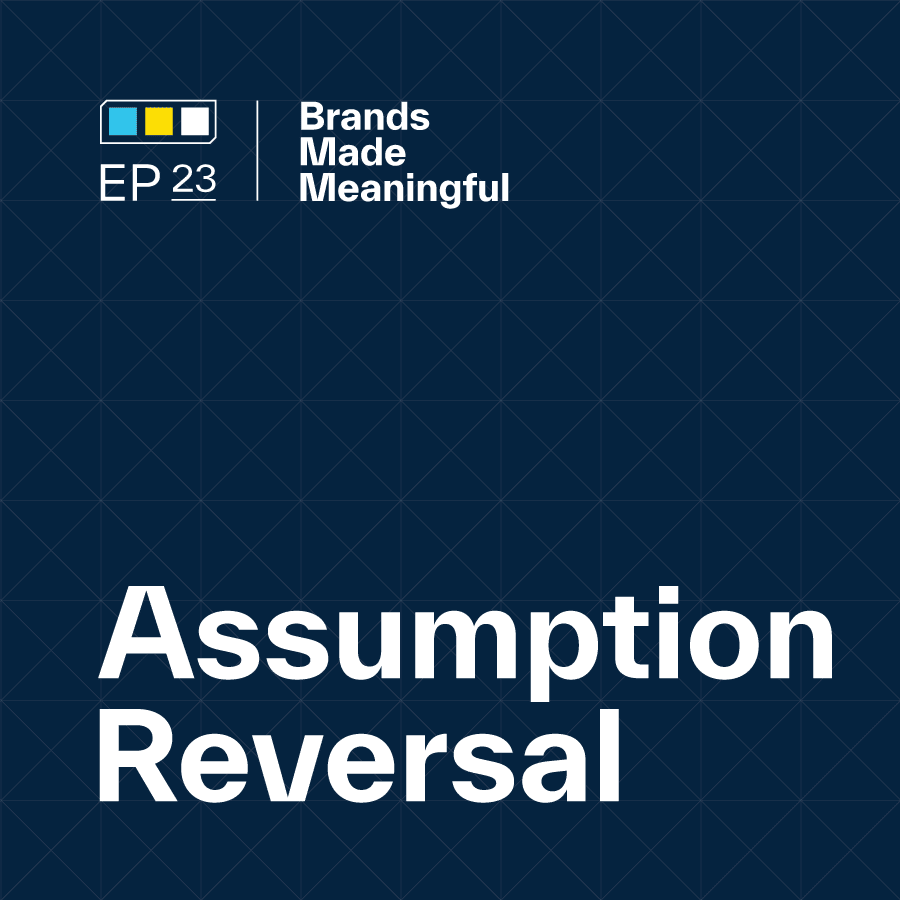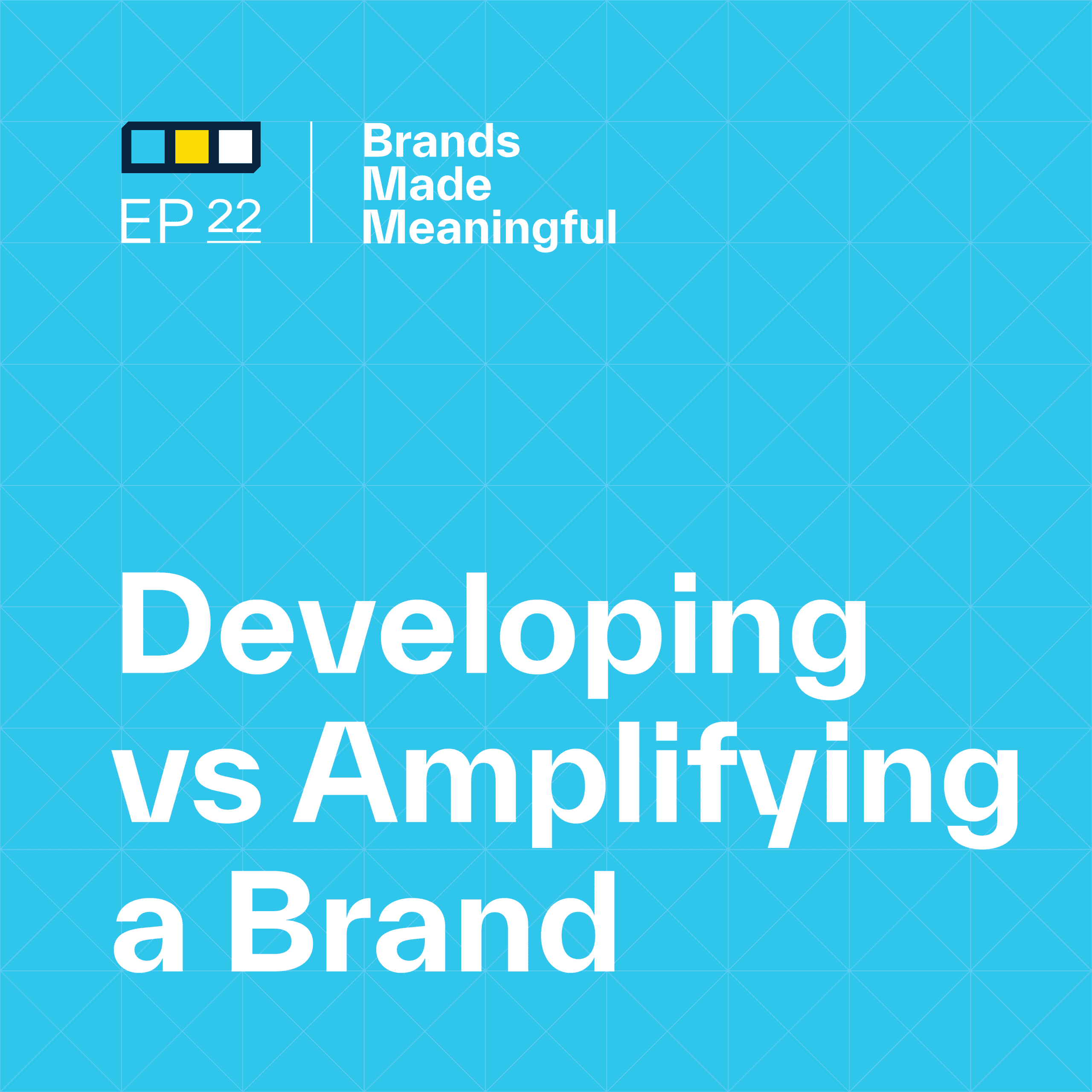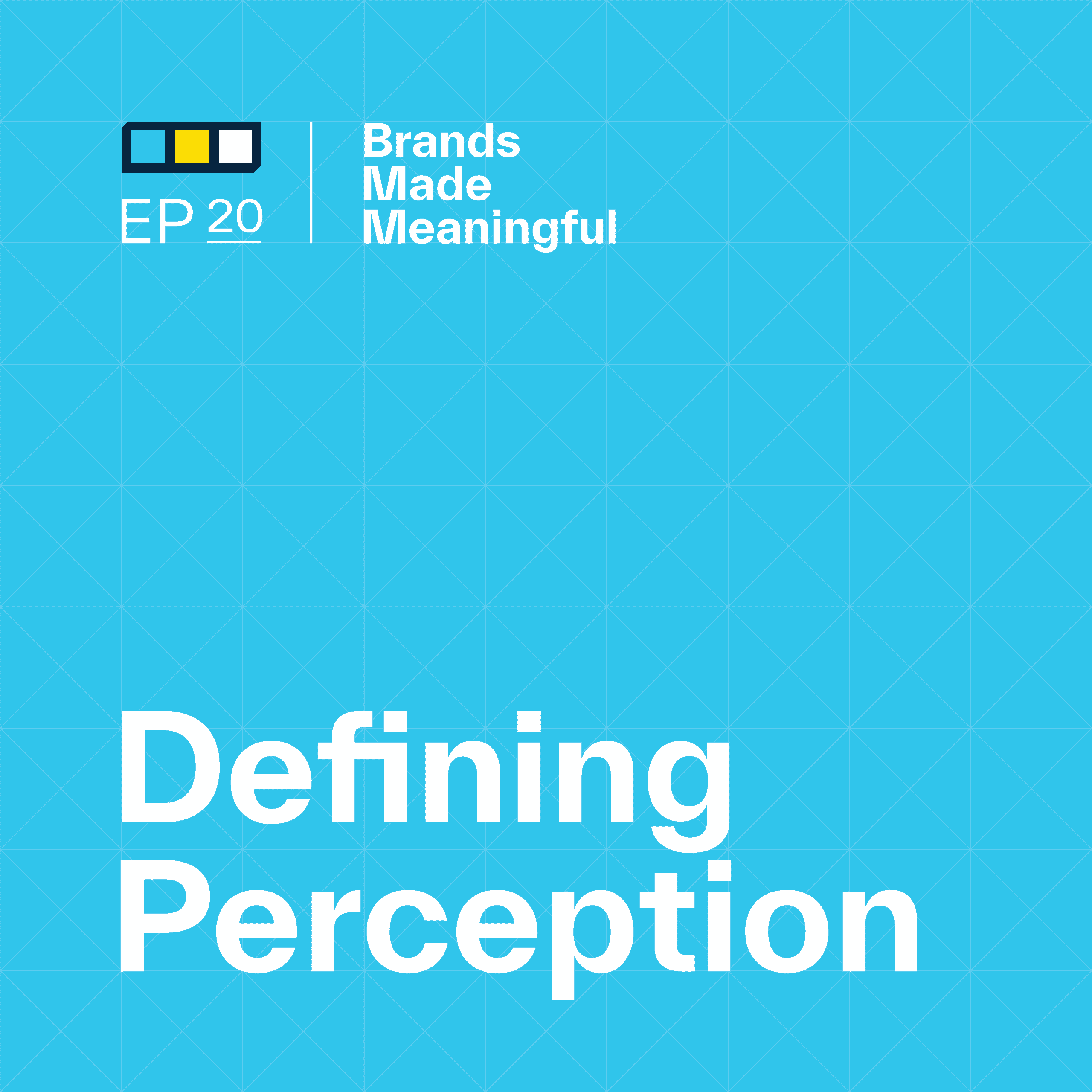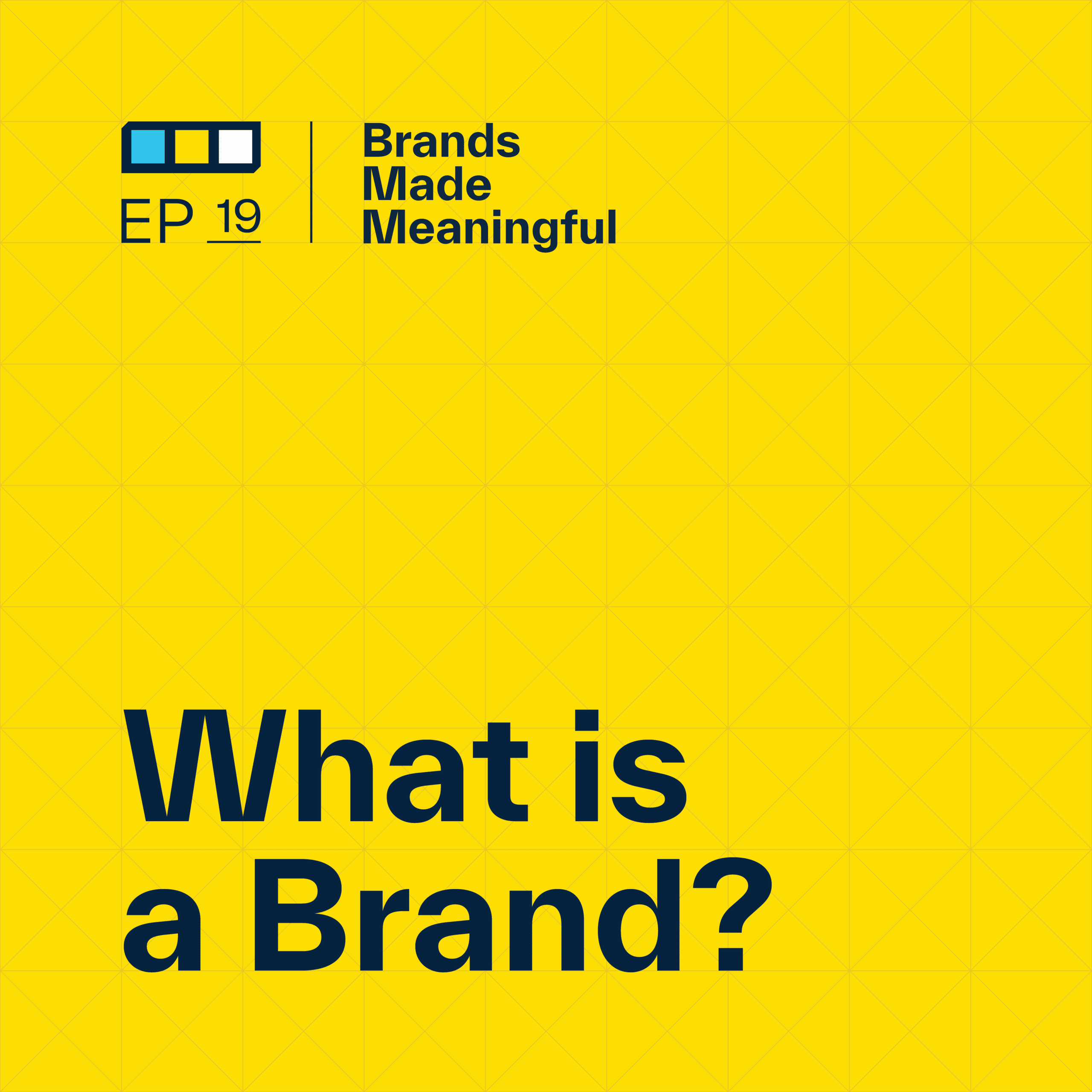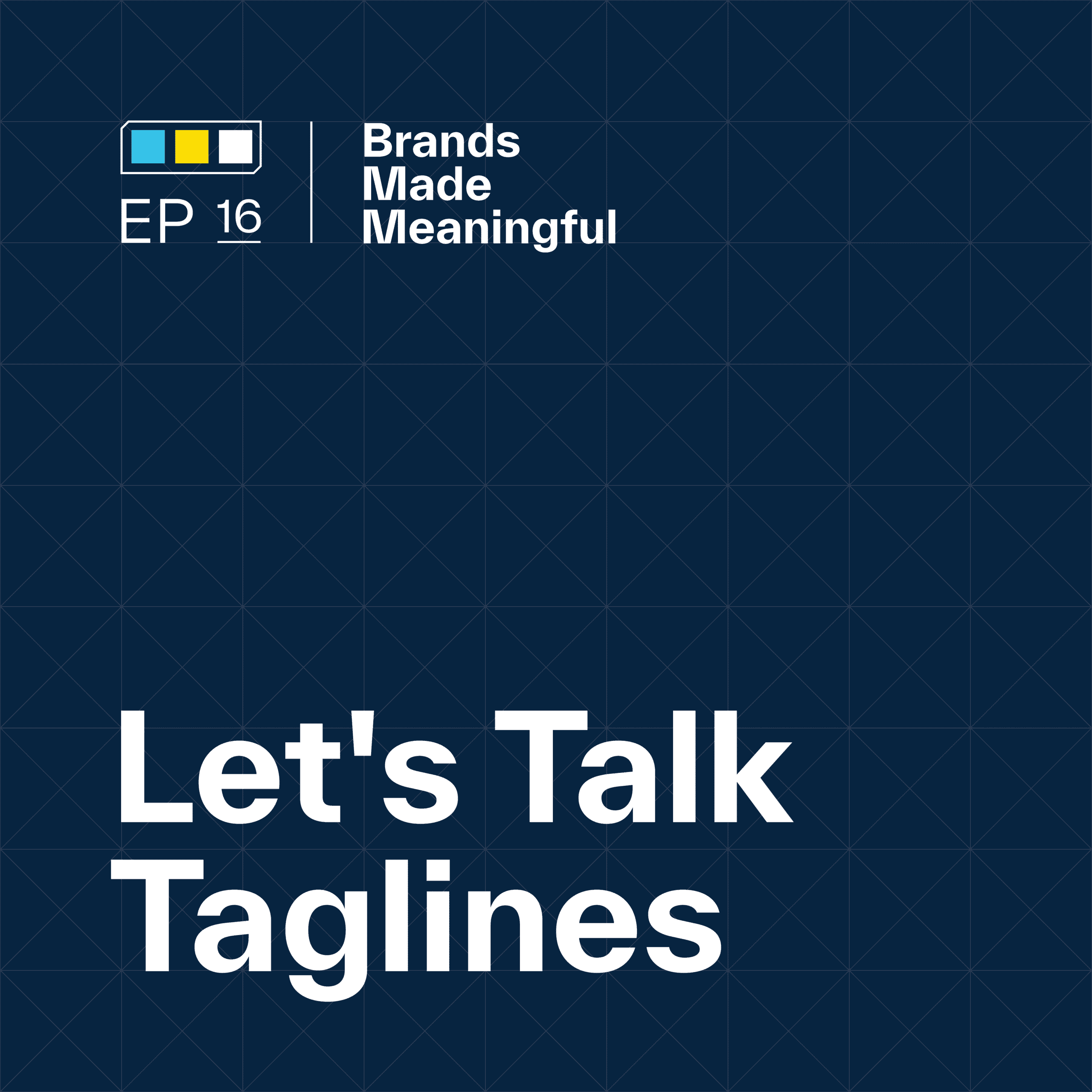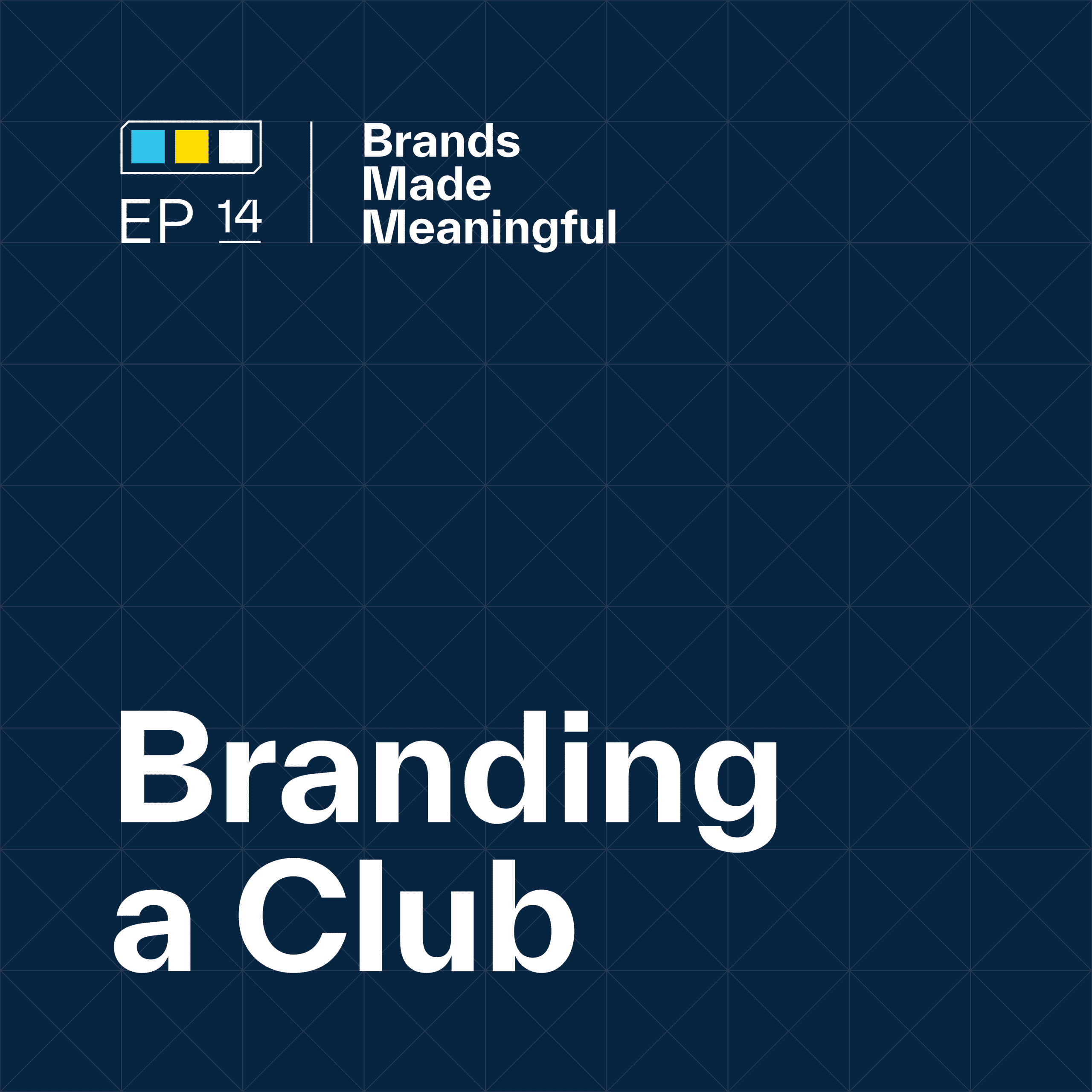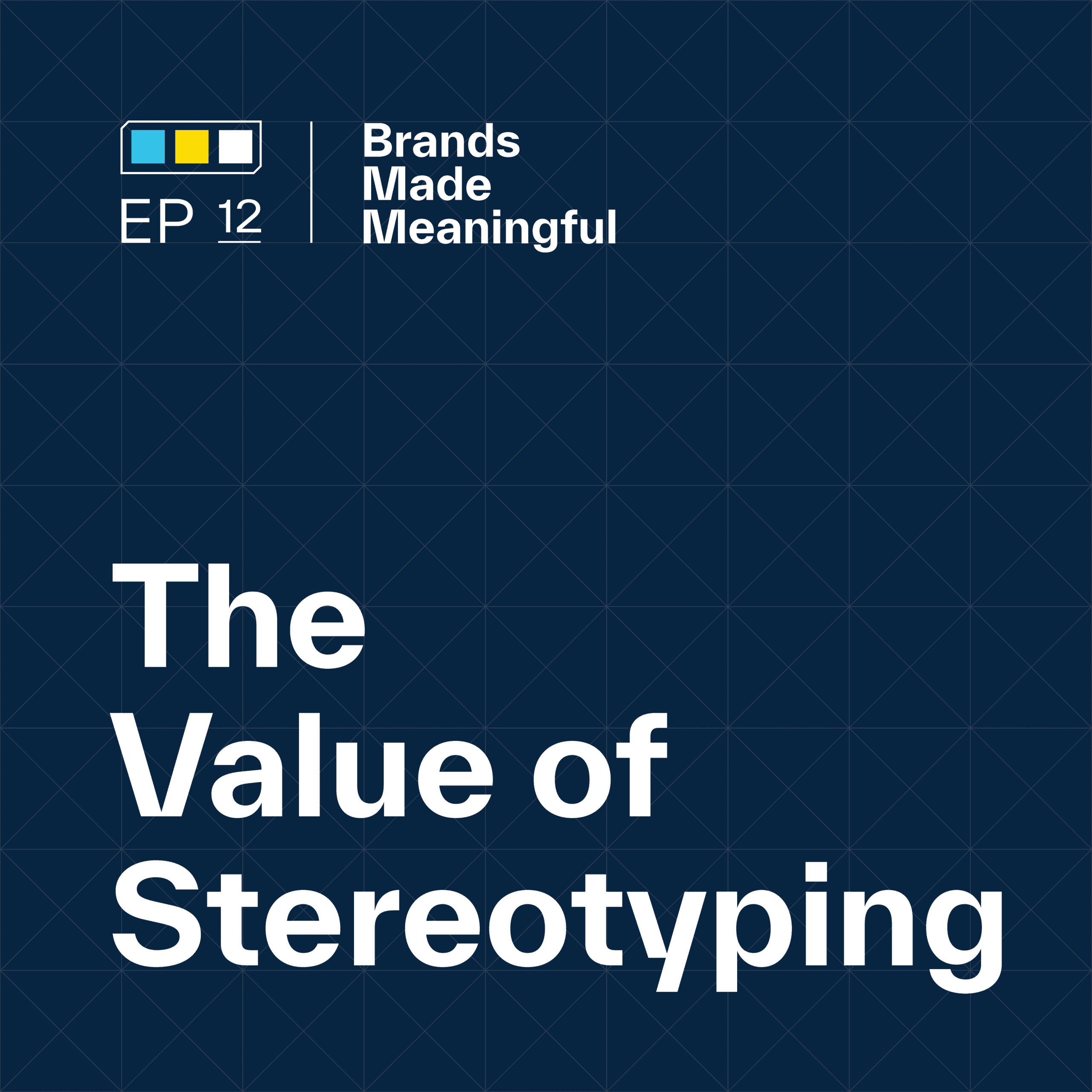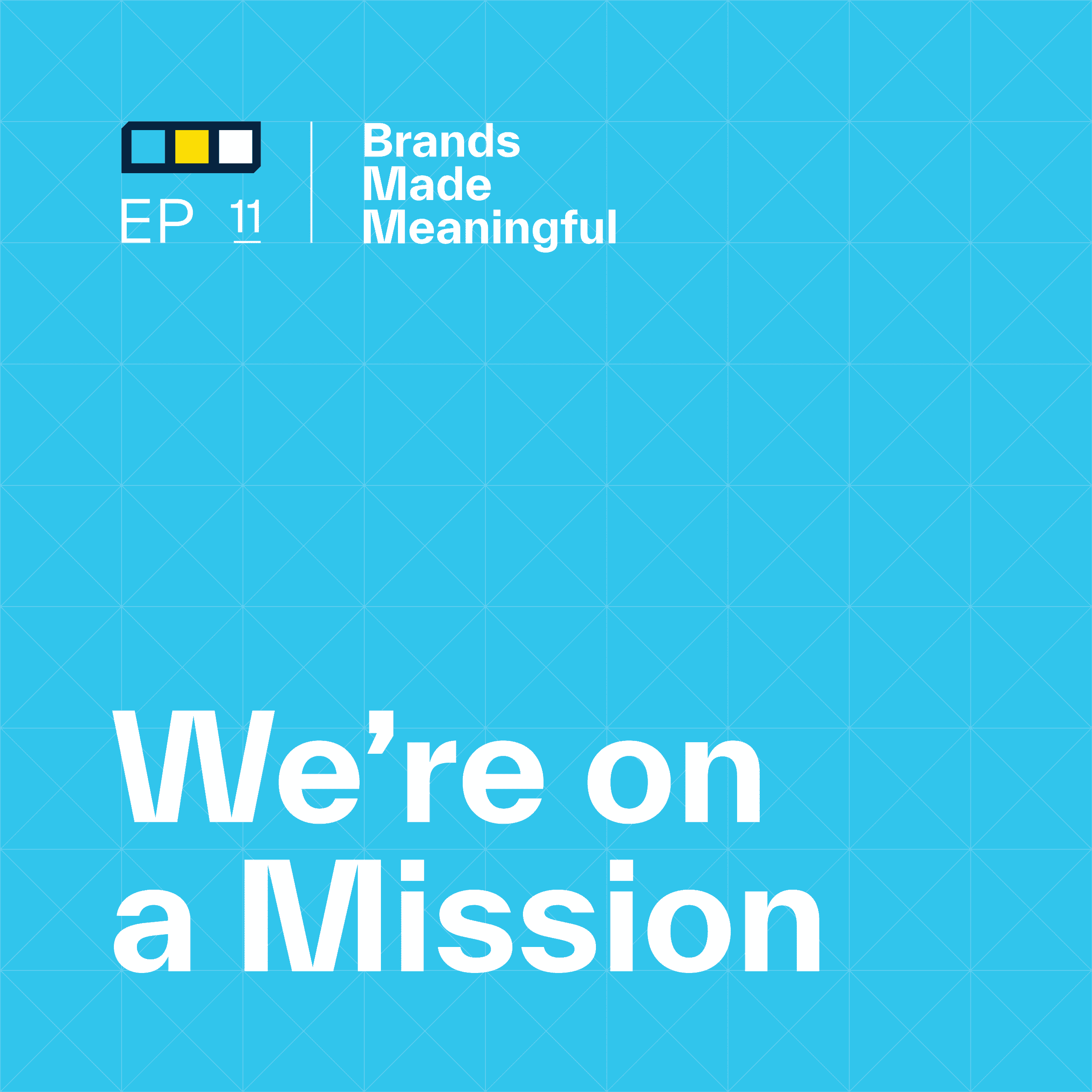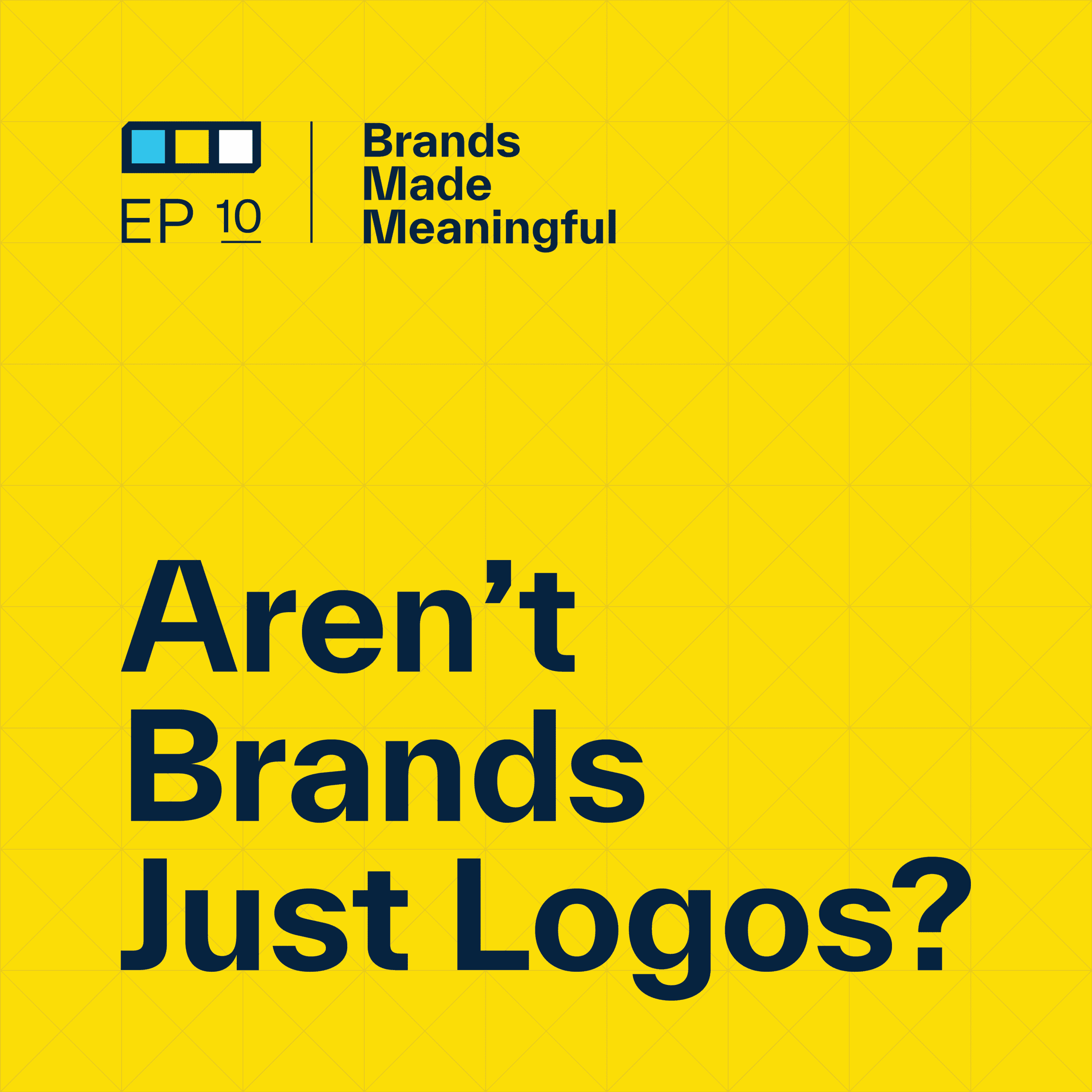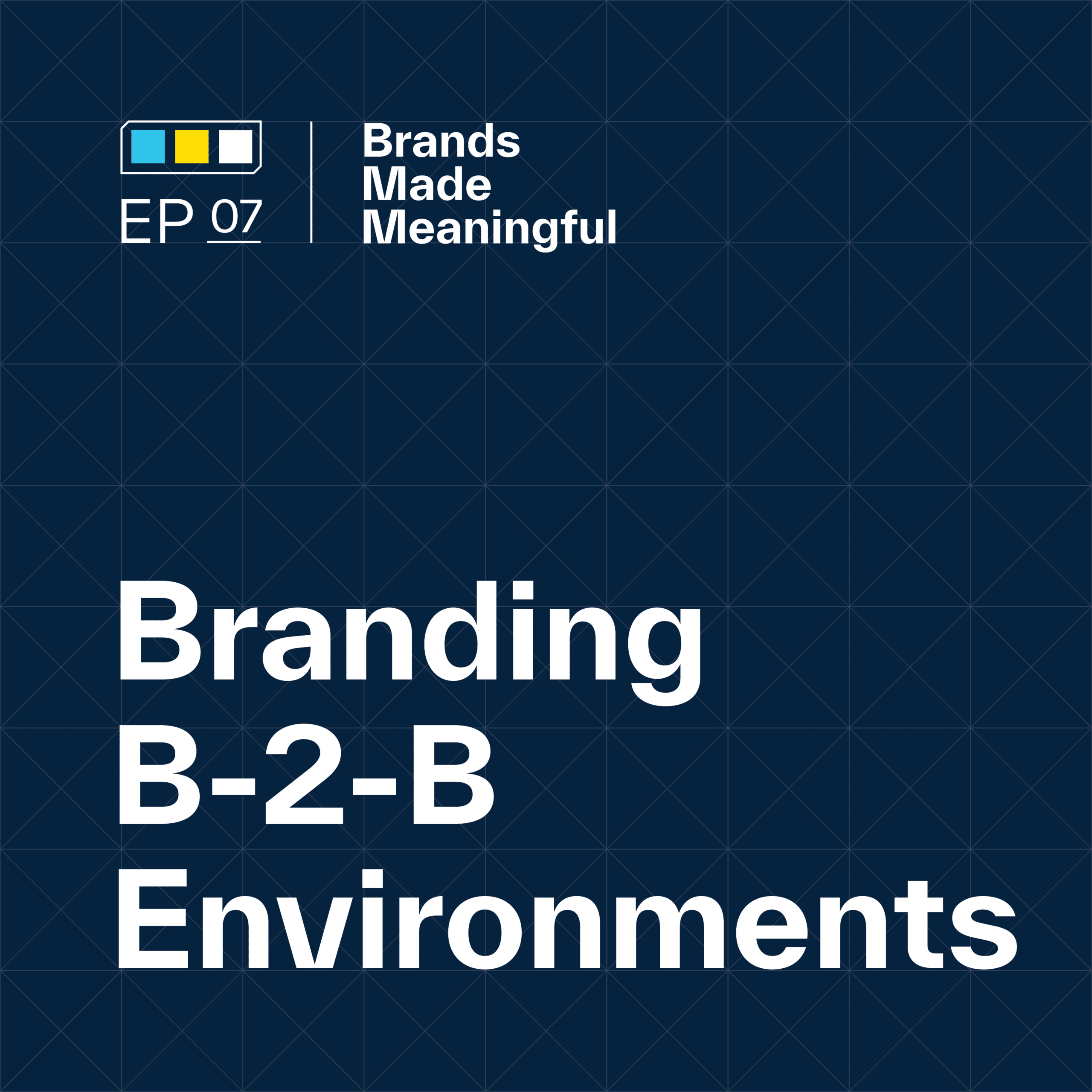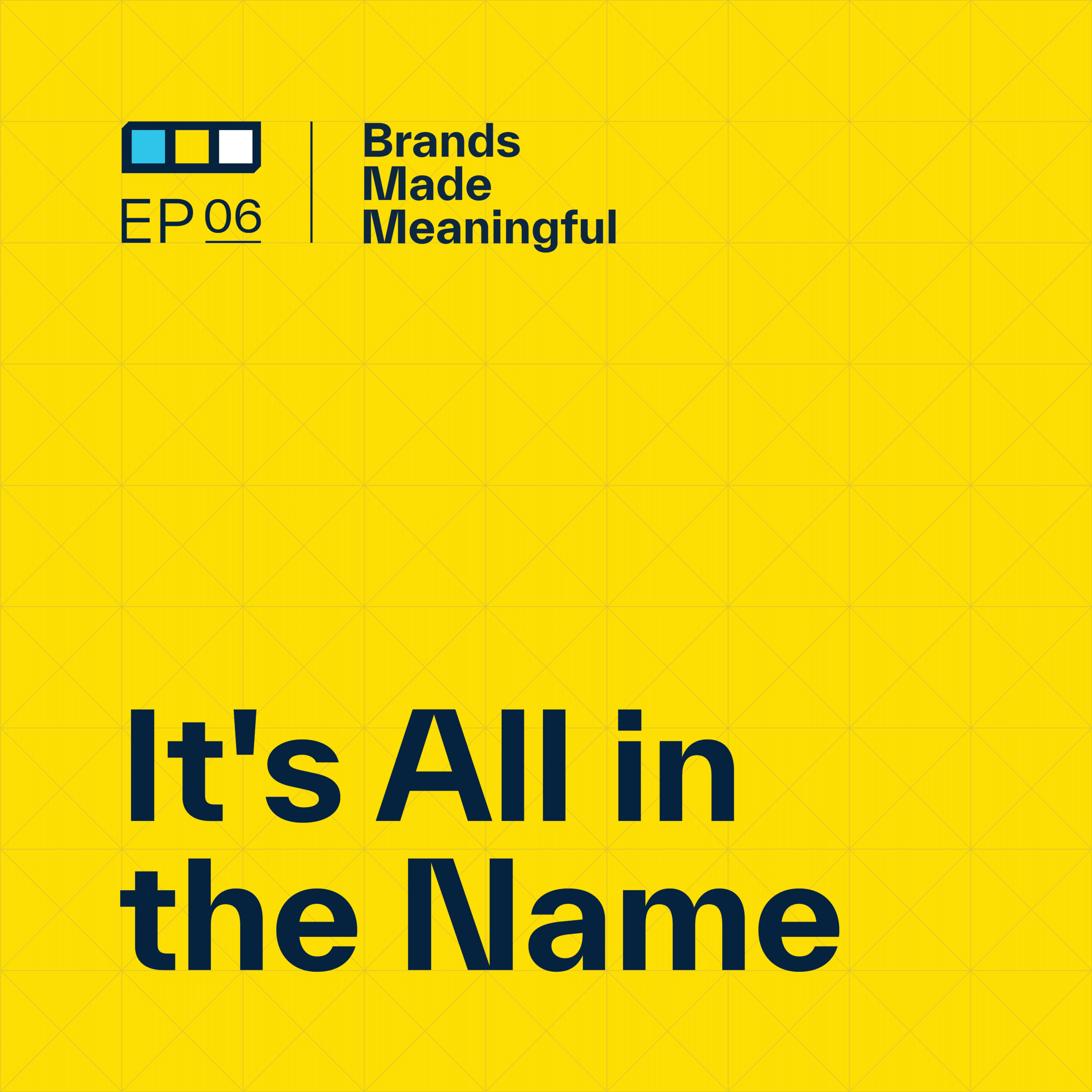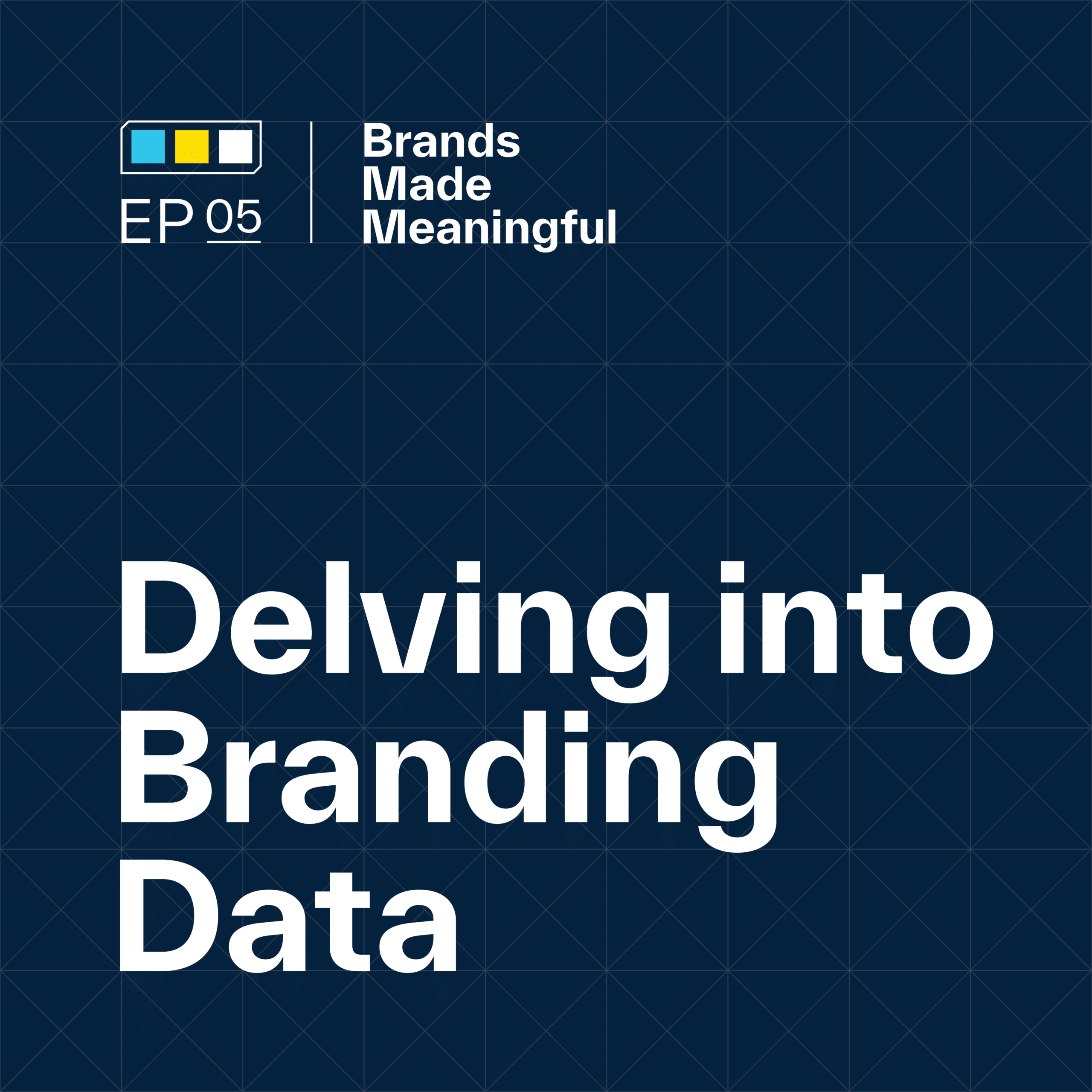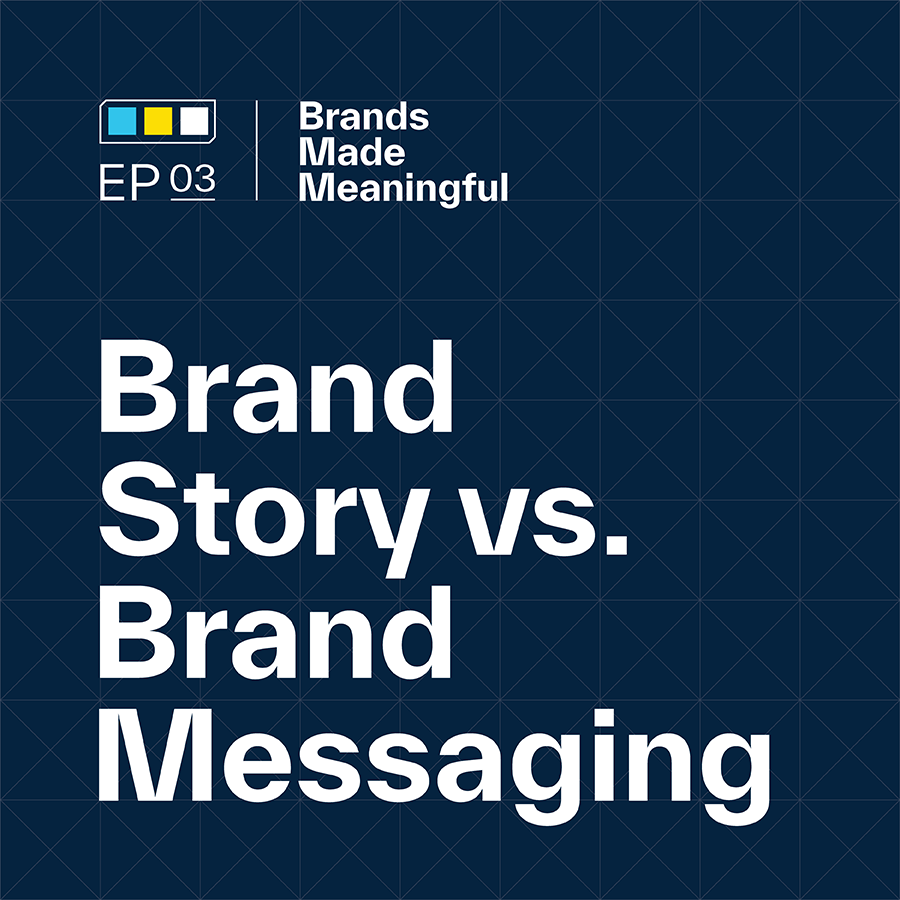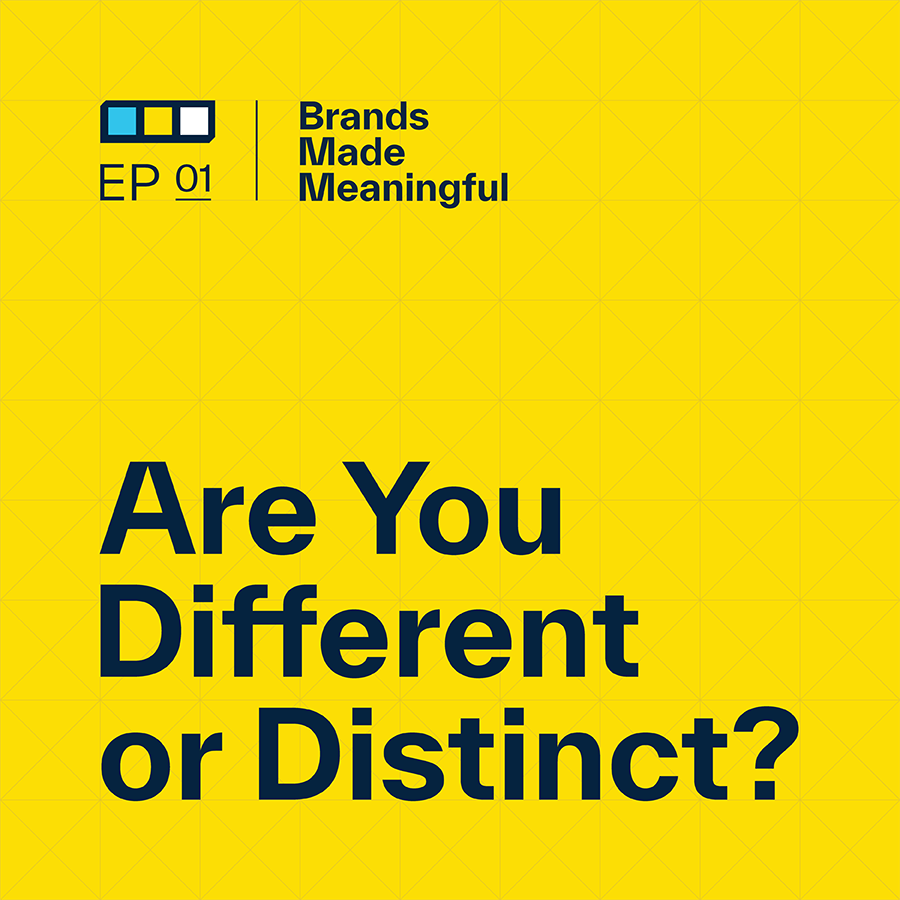EPISODE 46
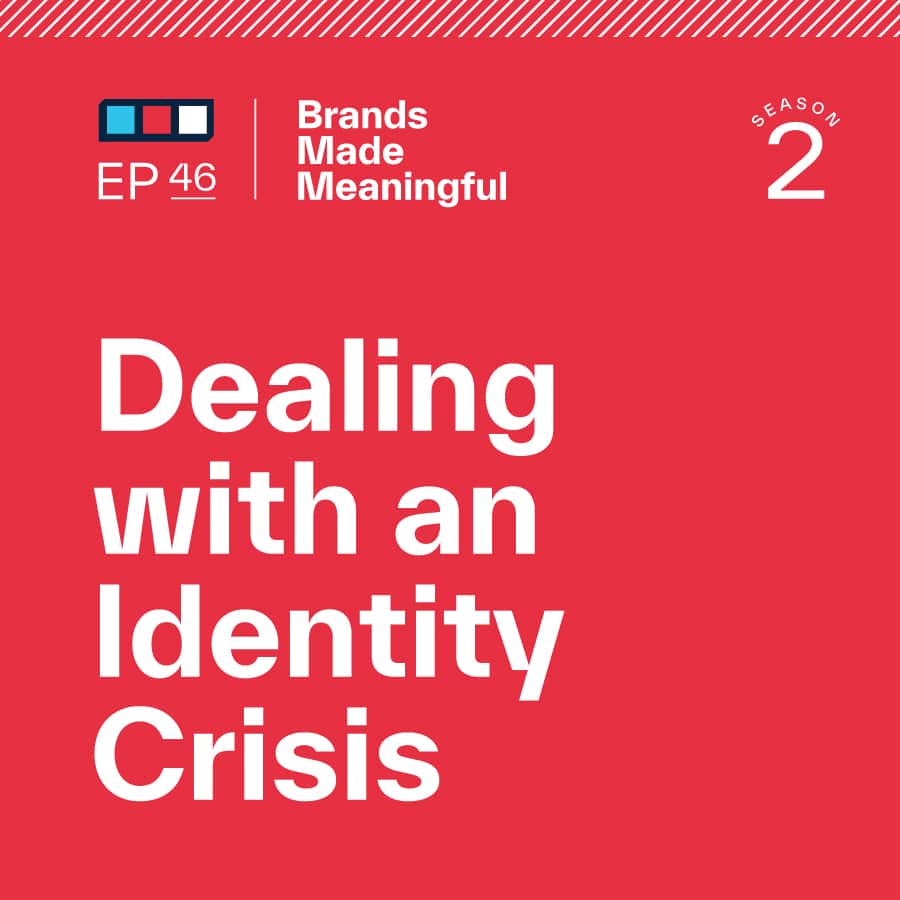
Dealing With An Identity Crisis
Episode 46
Derek and Tucker breakdown how to identify and remedy a brand’s identity crisis throughout thoughtful and intentional brand management.
EPISODE TRANSCRIPTION
Half of our conversations come with someone going – we don’t know who we are. We don’t understand who we are, what we do, or why we’re different.
Tucker When it comes to these type of big looming questions, a big part of the answer is found in your identity. And when we say identity, we don’t just mean your logo. We say that the question of who you are is what your identity is.
Expand Full Transcript
Derek And I think that feeling comes from a variety of places. Sometimes it comes from a misalignment or disagreement about why somebody has engaged us in the first place, or three different people in an organization that we’re talking with all have different goals for an outcome or what they think they’re hiring us to do. But I think a lot of times what we determine is that alignment is beyond cosmetic. It’s beyond we just want to look better. We want to sound better. Usually, the typical exercise is asking why three times, and I think you like to ask why seven, eight, nine, or ten times.
Tucker Until it hurts.
Derek To ask why until it hurts. We’re going to make a T-shirt and we’re going to start selling podcast swag. I think one of our store items is to ask why until it hurts.
Tucker That’s actually a really good thing. We actually said it last week during one of the workshops we did. I said, At some point, you will get frustrated with me. And that is the goal of this whole entire thing.
Derek Then I’m doing my job right.
Tucker Then I know that I’m asking enough questions when you start to say, Oh, my God, this is getting annoying. Because we’re getting down to where we need to get to because identity crisis is what we’re talking about today. It is not an easy topic to easily change.
Derek And out of that frustration, because I was in this workshop, ultimately came great clarity.
Tucker That’s the beauty of the work that we do. There’s a challenge, there’s an opportunity, there’s all these things that are looming ahead of us, and it’s going to get worse before it gets better. So let’s get there. That’s something that some very wise person told me one day. It’s always going to get worse before it gets better. And that’s so true with this. So today we’re talking about when people say this really feels off-brand. Maybe you’re a customer, maybe you’re a client of someone, and you go, Wow, they posted that thing. And it really does not feel on brand for them. Or maybe you were in a meeting with someone and you said, That just did not feel like it was our brand at all. And we’re trying to say, What is that feeling? Why is it important? How does our voice, how does our look, how does all of that connect together to make an authentic feeling, brand, or identity so that when we’re talking to people in the marketplace, people totally feel like they’re connected to us versus being disconnected and connected to some inauthentic thing.
Derek So we’ve qued up a fictitious scenario that says, Hey, you work in an organization.
Tucker This was a scenario I literally wrote down as I’ve seen a client come to us. I just took out all of the specifics. Let’s imagine you’re an organization and your company is maybe 15 years old and it’s built a really good reputation in, let’s say, the tech industry. And you specialize in a certain type of product or service, and you just recently begin to notice that some things are changing in your organization and they feel off and you just go, Well, that’s interesting. I just don’t think that that’s what we’re all about. An example is maybe there’s a product shift where your company starts introducing a new line of products that just don’t align with what you thought you were all about. Maybe your tech company is all about being environmentally friendly and all these products are made with non-organic stuff that can feel environmentally unfriendly. Or maybe you see a marketing ad or you go to your website and it’s running communication that is totally different than the one that you’ve become familiar with. And I’m not saying different as in they just changed a few things, but like now our values are different. Now we’re trying to sell a completely different benefit or unrelated focus. That can be a little like, Where did that go? How did that get there? Maybe you noticed that a lot of employees who have been there for a long time are starting to leave. And really the reason is unknown. You’re like, Wow, we’re losing a lot of our leadership. Or maybe a lot of turnover is happening and employee dissatisfaction can cause you to start thinking about what is going on. Those really lead you to believe that your company is shifting away from its core value, its core proposition, or its core reason for being in business in the first place. And that is making you feel like marketing, messaging, and internal practices are starting to feel out of place. That’s what we would call an identity crisis.
Derek I think this happens easily without people being aware that it happened or that it’s happening. This could be a company in any industry. This could be a golf club, this could be a professional sports organization. Especially in that 10, 12, 15-year-old mark, when you truly are what we would think of as a second-stage company, a company that’s proven its worth and value in whatever product or service it offers, and now they’re moving into a much more intentional growth mode and build off of what was a startup mindset into this next stage mindset, sometimes the purpose is the same. But 15 years can be an eternity in a business. There are so many changes. The market changes. What the next generation of demographic wants has changed. The demographic didn’t even exist 15 years ago when you started your business. That can go by in a blink of an eye. And you’re so busy servicing your clients, meeting your deadlines, delivering what you deliver, that it’s really easy to be working so deeply within the business that you forget to pause and step out and say, Okay, something doesn’t feel right. Something got away from us. What is that and how do we get it back?
Tucker If we’re going to generalize these things, because what I said is just a snapshot of what could be happening at an organization, really you’re looking at if you are inconsistent in different places. Are we unclear about what we do and who we do it for? Do we lack differentiation in the marketplace? Do we rebrand ourselves every three years? Do we have different customer perceptions? We talked to this one customer and they think of us in this way and we talked to a different customer with the same needs and problems and they think of us in a completely different way. Is that perception mixed? Do customers not trust us as much as they used to? These are all things that I would say point to an identity crisis for a brand, an identity crisis for an organization to say you probably don’t know who you are, at least to the point that makes you dangerous, that makes you really confident and makes you understand what you need to do moving forward to get to this great place you’re going.
Derek As I’m taking the side of the company and the people that got to this place and I’m trying to empathize with them in that, yes, you need to do something about this, I get how this can happen. We’ve been working with an organization that’s 25 years old in a rebrand that’s in the manufacturing space. And the reason and the purpose why the company was founded is still pretty consistent and valid today. But when we sat with their leadership team and just asked them what they do and who they do it for, they wouldn’t or couldn’t agree on an answer.
Tucker And they all have an answer. That’s not what we’re saying. It’s not like you ask the question and everyone says they don’t know.
Derek So how do you brand that? How do you message that? How do you market that misalignment within your own team if everybody’s not on the same page?
Tucker And that’s the challenge we’re posing today. What we find is that people have clear messaging, have clear branding, and have this confidence. That’s great. But what I kind of want to get into today more than any of those specific things is what do you do if you are not the CEO? What do you do if you’re not that person at the very top making that decision? How do you bring this up? Because we’ve been in organizations before where this is really a problem, but no one seems to want to say anything. And if you bring it up, then you’re ostracized. You are put out there to say you don’t trust where we’re going. So how would we bring up an identity crisis if we were inside of an organization to say we need to do something about this?
Derek And how to take that position and concern and bring it to your leadership, how to bring that to the CEO, the ownership, and to be able to present that in a way that they’ll listen is a great question.
Tucker Jump in.
Derek You need to prepare.
Tucker There’s a lot of preparation. You would say that dealing with someone’s brand and understanding when and where to say something is the exact same as having a relationship. Like talking to your wife and saying, All right, before you bring something up, you need to understand the situation. You need to really understand what the issues are, what the challenges are, and what the opportunities are. And you need to prepare your case. Come to the table saying, These are not all the challenges, but here is the opportunity we have, and here’s how I think we can move forward. This Is really how that first step starts.
Derek It’s identifying the problem and then it’s laying out a potential path to a solution. Back to the relationship – if you just come in and dump on this isn’t working, I hate this, I can’t do my job, I can’t sell, I can’t, I can’t, this isn’t working – it’s really hard to have a constructive dialog when somebody approaches leadership from that point of view, even if they’re right in what it is that they’re saying. How you say it and how you present it is just like a pitch or a presentation or a proposal or asking somebody out on a date. How you present that information is almost as important as the information that you’re presenting.
Tucker So what I would say is gather your evidence, gather your examples, and do things that say what a really great example looks like of something that we could do. But I would be super specific about the inconsistencies or the issues that you’ve observed saying what the problems are, why it’s a problem, and how you think that it has become a problem over time. You’d be surprised at how much you can learn just by understanding the issues in a really deep way because that can turn into a solution really quickly.
Derek Change is hard. And if the organization’s leadership is not totally disengaged and working completely remotely and they’re not tied in at all, it’s quite likely that if you went to the leadership and said you think there’s a problem with the brand’s identity, you’re having a crisis of identity with who you are, and that’s causing some challenges that you have an opportunity to fix, I think that most leaders worth their salt are probably already aware of it. In the end that might sting a little bit to hear because it may feel like you’re implying that they fell asleep at the wheel in some way and they might take that personally. But I think if you’re coming from a good place and you’re brave enough to bring that to the table, they’re probably already aware of it in some way.
Tucker So if we talked about the first thing is to prepare your case. The second part is to choose the right time and right place. Don’t do it right before a big meeting with a huge client and say, Wow, this all really sucks and I wish we did way better than this, and then go right into the meeting. That seems super obvious. But we’ve seen times where people bring things up, especially within a brand sense, and they don’t understand what they’re saying. They don’t understand the importance of what you are saying. Because if you go, we don’t know who we are, and then you just go into the next thing, there’s a lot that goes into it. To your point, there’s a weight on a leadership’s shoulders to go, Oh my God, my team doesn’t know who we are. That’s a problem. And if you do it at the right time in the right place, then that can come across more as thinking we could solve this instead of good luck. Because those two things are very different when you deal with them.
Derek Well, (a) the leadership might already know who the organization is and may just not have done a good enough job of communicating who that was.
Tucker The third one that I’m looking at, which you’ve already touched on, is to be constructive, not critical. Because most of the time there isn’t someone who is all in on your organization’s brand. There is not a brand manager all the time. I think that most of the organizations that we work with that have these identity crises are people who have a marketing team but their jobs are to do all these other things. And it gets hard when you get stacked with tactics to understand and say, Oh my God, we are going down a different route here and this is not who we are, who we want to be.
Derek I remembered the (b). The (b) is in that constructive way of presenting that information, to make sure that you’re expressing that is coming from a good place. If a team member or an employee has the bravery to approach you with something that I think of as critical as an identity crisis, it means that they care. If they didn’t, or they didn’t see a solution or a path forward, or they didn’t see that this organization got us here because of some very specific wonderful things and they see an opportunity for us to continue to excel and grow into a place where we could be going, they never would have come to in the first place. They would have just left.
Tucker When I bring my case to the forefront and I am not critical but I am very constructive and I’m picking the right time and place, I would really use examples. If you have data, use data. If you can say we’ve really lost a lot of loyalty across the last couple of quarters in our sales and here is where we’re seeing a downturn and what had happened, if you can tie some of these things to data, you’re speaking the leadership’s language. You’re understanding what we need to do and here are the things I’m noticing that are key indicators that we’re not doing what we need to do or who we are.
Derek Like I said, then follow that up with solutions. Don’t just dump, dump, dump, and dump some more and then say, Okay, now you guys better figure this out. Hopefully, you’ve thought enough about this to where you at least have some inkling on some other new steps forward.
Tucker I think that when people bring these challenges to the forefront and they have these conversations, then it becomes easier to see a way. So what I mean by that is when you’re a leader and you’re receiving all of this, you would think criticism, but maybe it’s constructive criticism, to come back and say, You know what, I think you’re right. I think that we are not perfect. No brand is perfect. There is no such thing as a perfect brand, in my opinion. It’s just like there’s no such thing as a perfect person. But that is a really hard thing to admit as a leader, to say, under my watch this has gone this way. It’s also really easy to say, No, we’ve always done it like that. This is how we do it. And that’s a really, really hard thing as someone who’s not a leader to hear because that can point you to say, Well, now I don’t care.
Derek My colleague Tim Kierans said, and I’m not sure who he brought this forward from, but his term is the seven words of a dying business. I could use it to say the seven words of a dying brand are “because that’s the way we’ve always done it”.
Tucker And you would be surprised how often we actually hear that. I hear that at least a couple of times a year when a client has said, Well, we’ve just always done it like that. I don’t get why that’s a problem. And we would say, Okay, this is how we would do it. And it’s, Well, that’s okay. That’s just how we’ve always done it. That’s the way we’ve always been thought of. That’s the way our fans always react to us. So that’s totally fine. And I think that the people who have been in their seats for 10, 15, or 20 years managing the brand or managing marketing for a certain organization find that you can get narrowed focus into what you know and what you don’t know. And to your point, you said demographics, but I think psychographics, change over time. They change by generation, they change by preference. Things happen in the world that change the way that people want things and need things. And I think that if you are a leader and you’re not critical of your own brand every three years, I’d be watching out because those things change on a dime.
Derek Sometimes you need an outside perspective too. And this can go as large as a professional sports organization that thinks that they’re all about just winning a world championship. That’s an identity crisis. That ripples down all the way through every staff member of the organization and can cause them to second guess what their role and purpose is within that organization.
Tucker It gets really hard, especially for teams like you’re referring to, to then step back and say, We could be more than just winning. And that’s super hard. I empathize with that because their business hinges on winning and losing. So it’s going to be hard to say, We’ve lost, and now what? But if you anchor everything, and this is true with other businesses too, on winning and you don’t win, then that’s a problem. But if you anchor everything on winning and then you do win, now are you just a winner? Is your identity a winner? Then I think that that puts you in an even harder place. It’s easy when you don’t win to say that all you want to do is win and always go after that. That’s easy. But to win and say, Okay, now what? After decades of wanting to be a winner, that’s hard. You see the people who do what they love and they figure it out and then they do it and then afterward they don’t have an identity. Their identity has been solved. And that’s a crisis to say, We don’t know who we are now and where we’re going because we’ve already gotten to the hilltop.
Derek And the same thing for this fictitious organization that’s 15 years old that’s been winning enough and has been successful enough over that decade and a half to get to the place where they’re getting without realizing that all of a sudden they’ve lost whatever vision that got them there in the first place is causing them to have gotten stuck somehow.
Tucker Then you step back and you go, Okay, we’ve been doing this for a long time and there’s a new shiny object. We talk about this with our clients too. Sometimes there is a point where you want to go do something just because it’s a new thing. That can be a distraction as well.
Derek I talk about EOS from time to time and within the EOS framework, within that business operating system, they have you put together a three-year picture, a three-year vision, that helps you weigh those decisions to help prevent shiny, bright sidetracked things from taking your attention away from what it is that you’re trying to do. But if you aren’t intentional about having defined that place that you’re going, who you’re for, what you’re for, and why you do it, it’s really easy to get distracted. It’s easy to get distracted by something that might help you make a bunch of profit quickly, or an opportunity that looks easy but turns out it’s not, or going into markets that you think you have a right to go into when actually would be a complete waste of time.
Tucker And it’s really easy for your teammates to roll their eyes or throw their hands up and be like, What are we doing here? I signed on for this and now we’re doing this. And this is where leaders get frustrated sometimes and say, You guys just don’t see it. As a leader, you’re supposed to make them see that. We just heard earlier today that someone said, Keep it simple, stupid. As a leader, my job is to take the extreme complexities and make it easy for you to find that path forward so that you can follow us down that path. And so to me, that’s a perfect example of saying if it’s so hard for someone to understand, either you’re not doing a good enough job of explaining it, which is totally fine, or it doesn’t make any sense from their perspective because it’s just a distraction.
Derek We’ve talked about how a team member can approach leadership. What if it’s the leadership? What if the owner, the leader, the CEO, the marketing director of a company who’s come on board says, Oh my gosh, we have an identity crisis? There’s misalignment. I don’t know who we are. I have a lack of clarity. Maybe that’s why I was hired to help this company in the first place. What are the first two or three steps that we would typically advise them on?
Tucker The exact same thing that we’ve already said. I would advise them to prepare the case and build a deck that says here’s what I’m seeing, here’s the inconsistencies I’m finding, here are the issues with that, and here is the opportunity that I think that we could have. We’ve seen that deck. I’ve seen marketing leaders put that together to say, I’ve come in now and I see what’s going on here. And I think that this is the right path forward. It makes it easier because you are the one who people are looking at for those types of answers. But I still think it all remains the same. Prepare your case. Choose the right time and place to have that conversation – probably at some quarterly marketing meeting or some kind of start small, ask people about it, get their opinion – and have the conversation. There might be more to it than you know, especially the newer people. We’ve seen CMOs come in and say, I’m changing this, this is what we’re doing. And everyone’s like, What are you talking about? And that can backfire really hard as well. So I think that there is gather information, roll it slowly, gather more information, and roll it out slowly. And by slow I mean like in the matter of a couple of weeks or something. Not years, obviously. But when you’re coming back to this, as you use examples, as you use data, as you use talking points, those become a storyline in itself that starts to build within the organization. When you tell one person or you tell a group of five people, one of those people might totally agree with you and take that and go, You know what? I think that we could be doing this better. It just grows from there.
Derek We’re not talking about business turnaround. We’re not talking about a business that’s potentially failing and about to go out of business and how to right that ship or right a sinking ship. That’s a different specialty. We’re talking about an identity crisis, a brand crisis. Sometimes this whole process takes a long time of steady, consistent focus. On occasion, the solution is easier than you think once you’ve taken the time to investigate and look at what some of these potential solutions might be. Sometimes it might not be that you’re sinking or adrift. It might just be that you just need a little bit of adjustment, that you haven’t taken the time to get back on this new track.
Tucker You could be stagnant. You could just be like, Wow, we could be so much more. Why? What are you seeing out there? And I think that some people will be able to get there and some people won’t. You’re right. We tell people all the time another benefit of rebranding or branding yourself is to keep killing it. You just keep doing great stuff. But sometimes that’s exactly what you need to say, We’ve just been stagnant. We have a great product but we’re just stale
Derek We’re leaving too many runners on base. We’re not scoring enough runs. And how come? If an employee comes to you, and I speak from experience looking at our new camera, thanks to Cameron. Shout out to our producer. If an employee of yours is brave enough to come to you and make the case about some challenges that your brand has with respect to its identity, take a deep breath and listen to them because most of the time, I believe they’re coming to you from a really good place. And if you listen to them and join in the conversation and think about what those solutions could be, it could lead to some really, really great outcomes for your organization.
Tucker Be totally open to changes. The brand is a very personal thing for a lot of people. Even if you’re a billion-dollar company and you run parts of the marketing department, you still feel a personal connection to that brand the way it’s seen in the world. It’s not a personal attack on you to say the brand isn’t what I think it could be. And that’s the kind of conversation that’s healthy for your organization.
Derek Brands are a living, growing entity that need to be nurtured, fed, and taken care of. You can’t just build it, create it, and forget about it. It has to be something that we are working on in some way, shape or form consistently.
Tucker Feed that brand.
Derek Another T-shirt idea.
Tucker Feed it. All right. Thanks. Till next time.
Derek Until next time. Sussner is a branding firm specializing in helping companies make a meaningful mark, guiding marketing leaders working to make their brand communicate better, stand out, and engage audiences to grow their business. For more, visit Sussner.com.
More Episodes Like This
Building Brand GuidelinesEpisode 65
Derek and Tucker show us how to build infrastructure guidelines to unify your brand experience across the board.
Club Identity SystemsEpisode 64
Derek and Tucker cover what Identity Systems entail and how to discern between internal and external methodologies.
Navigating Branding With a BoardEpisode 63
Derek and Tucker bring clarity to uniting your company under one cohesive vision.
Putting a Committee TogetherEpisode 62
Derek and Tucker assemble your need-to-know facts when putting together your committee.
The Guiding Principles of Private ClubsEpisode 61
Derek and Tucker go over the top ways private clubs can find the balance between pleasing old members while attracting new ones, all while making moves towards the future.
How Color Affects PerceptionEpisode 60
Derek and Tucker cover how to best convey your business with color.
Brand EcosystemsEpisode 59
Derek and Tucker break down how to craft effortless experiences when considering your brand as a whole.
6 Types of Brand TransformationEpisode 58
Derek and Tucker dive into 6 distinct types of transformations for a wide range of brands.
Tournament Branding For ClubsEpisode 57
Derek and Tucker discuss designing and delighting your club members with tailored events.
Brand Promoters & DetractorsEpisode 56
Derek and Tucker discuss how high level promoters increase your NPS and how to turn the tides on your detractors.
The Loudest Voices in the RoomEpisode 55
Derek and Tucker talk about gathering feedback while prioritizing every voice.
Determining A Primary AudienceEpisode 54
Derek and Tucker discuss if and when you should be honing in on your audience vs. casting as wide a net as possible.
Branding For ExclusivityEpisode 53
Derek and Tucker discuss the intricate process of naming your brand.
Measuring Brand SuccessEpisode 52
Derek and Tucker discuss how we measure our success in branding and a few key KPIs that help us understand our impact.
Branding For ExclusivityEpisode 51
Derek and Tucker breakdown how brands can create the perception that they are exclusive and only for a certain type of consumer.
What Makes A Brand SurprisingEpisode 50
Derek and Tucker break down the Sussner formula that we believe leads to a surprising brand.
Breathe Life Into Brand TraditionEpisode 49
Derek and Tucker discuss the intricacies and common pitfalls of branding for Private Golf Clubs.
They Key of Visual DifferentiationEpisode 48
Derek and Tucker break down the importance of differentiating your brand on a visual level.
Branding For Private GolfEpisode 47
Derek and Tucker discuss the intricacies and common pitfalls of branding for Private Golf Clubs.
Dealing With An Identity CrisisEpisode 46
Derek and Tucker breakdown how to identify and remedy a brand's identity crisis throughout thoughtful and intentional brand management.
Branding vs MarketingEpisode 45
Derek and Tucker discuss the differences between Branding and Marketing and how to make the two compliment each other.
Build Your Brand's FoundationEpisode 44
A brand's foundation is a critical element in being successful in the long-term.
Building a Constructive Branding ProcessEpisode 43
Derek and Tucker break down the steps required to build the most constructive and meaningful branding process.
What Makes a Brand Relevant?Episode 42
Relevance is a key piece of a brand's identity for creating clarity and connection.
Your Right to WinEpisode 41
Derek and Tucker discuss the “Right to Win” and the odds of your brand's success within your target market.
An Intro to Sub BrandingEpisode 40
Derek and Tucker discuss the nuances of developing sub-branding and strategies.
Conquer Branding FearsEpisode 39
Derek and Tucker dive into how to overcome the fear of change and the nature of constant refinement of your brand.
Balancing Strategy & DesignEpisode 38
Great strategy is a necessary foundation for great design—and great design brings great strategy to life.
Branding PrioritiesEpisode 37
Branding priorities are the actions and initiatives that shape or enhance a brand's identity, perception, and market position.
Invest in Your BrandEpisode 36
Investing in your brand benefits your company as a competitor in the marketplace, builds trust with customers, increases perception of quality, and drives employee engagement.
Why is Positioning Scary?Episode 35
Narrowing the brand's position is really a strategic decision to focus the brand's offerings, messaging and target audience on a specific niche or segment within the market.
What Are Brand Consultants?Episode 34
Derek and Tucker discuss the importance of hiring expertise with a wider breadth of knowledge than just visuals.
Hire for Brand FitEpisode 33
Hiring people that fit your brand is key in order to maintain brand authenticity, positive culture, and consistent messaging.
Your Brand’s Stance MattersEpisode 32
Your stance can help define your brand from a core level and make branding, hiring, and marketing not only easier, but more meaningful.
Levels of Executing a Brand RefreshEpisode 31
If you have a brand strategy in place, how do you execute it?
The Role of Features & BenefitsEpisode 30
Derek and Tucker discuss the importance of features and benefits within the context of branding, selling, and marketing your products and services.
Should You Listen To or Lead Your Customers?Episode 29
Within the challenge of any rebrand is the challenge of managing customers' perception of change.
Managing a Brand TransformationEpisode 28
Episode 28 discusses the highlights and challenges of rolling out a new brand, both internally and externally.
Living Your BrandEpisode 27
Your brand is not this shiny trophy on the shelf. It is something that you are molding every single day.
What Makes a Brand Authentic?Episode 26
Season 2 starts off with a discussion about building authentic brand experiences, both internally and externally.
Reviewing your Competition's CreativeEpisode 25
Derek and Tucker discuss the process of reviewing your competitors' creative strategy to better position your brand within the market.
Interviewing your Audience for InsightsEpisode 24
This episode details the process and benefits of interviewing your audience as part of the branding process.
Assumption ReversalEpisode 23
Derek and Tucker discuss how we change our thoughts and get into a different mindset to refine and revise our branding.
Developing vs. Amplifying a BrandEpisode 22
Another way to say it is, development is building and crafting your brand story, and amplification is then telling it.
Refreshing a Sporting Goods BrandEpisode 21
This episode shares the steps behind Sussner’s work in refining the Shock Doctor brand.
Defining PerceptionEpisode 20
Derek and Tucker discuss the positive and negative impacts of brand perception.
What is a Brand?Episode 19
Derek and Tucker discuss what defines a brand and what makes them successful.
Branding Golf Courses vs Golf ClubsEpisode 18
Derek and Tucker further hone in on golf course design.
Refreshing a Golf CourseEpisode 17
Derek and Tucker discuss the bar for golf course design – and how to push past it.
Let’s Talk Taglines Episode 16
Derek and Tucker talk taglines in today's episode.
Refreshing an Athletic DepartmentEpisode 15
Derek and Tucker sit down today to discuss what logos mean within branding.
Branding a Club Episode 14
Derek and Tucker discuss how to brainstorm branding a club.
An Intro to Internal Branding Episode 13
Derek and Tucker discuss the power behind internal branding.
The Value of Stereotyping Episode 12
Derek and Tucker sit down today to discuss the meaning of stereotyping within the branding world.
We’re on a Mission Episode 11
This episode digs into the rallying cry for the greatness your team is going to accomplish.
Aren’t Brands Just Logos? Episode 10
Derek and Tucker sit down today to discuss what logos mean within branding.
The Business You Are Really In Episode 09
Derek and Tucker sit down today to discuss how to discover what business you are really in to better understand your mission statement.
Clarity of Vision Episode 08
Derek and Tucker discuss the importance of looking ahead towards the big picture to better hone the purpose behind what we do in the now.
Branding B-2-B Environments Episode 07
Derek and Tucker discuss the Branding of Spaces.
It’s All in the Name Episode 06
Derek and Tucker discuss what a name can say - and not - about your company.
Delving Into Branding Data Episode 05
Derek and Tucker jump into the discovery phase of branding before it hits the drawing board.
Content Made Meaningful Episode 04
Today Derek and Tucker discuss the concepts within content and its common misconceptions such as the phrase "Content is King."
Brand Story vs. Brand Messaging Episode 03
Your story matters.
Visuals That Take The Cake Episode 02
Derek and Tucker sit down to discuss visual impact and what that could mean for your brand.
Are You Different or Distinct? Episode 01
It's not about being the only option, it's about being the right option. Join Derek and Tucker as they discuss Differentiation & Distinction.


